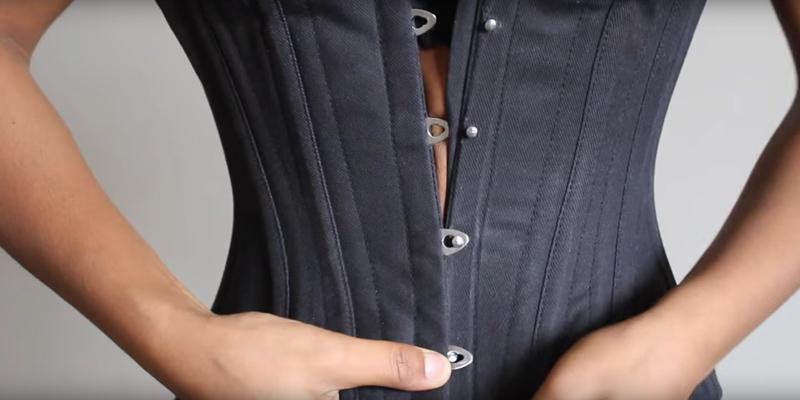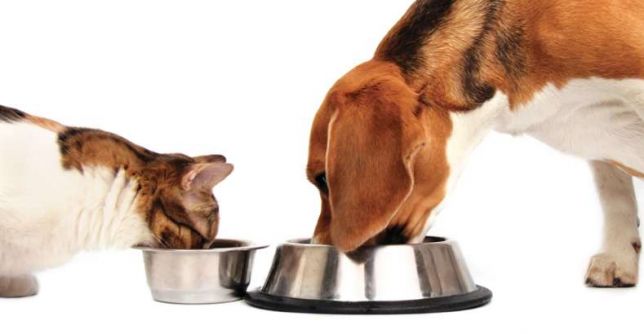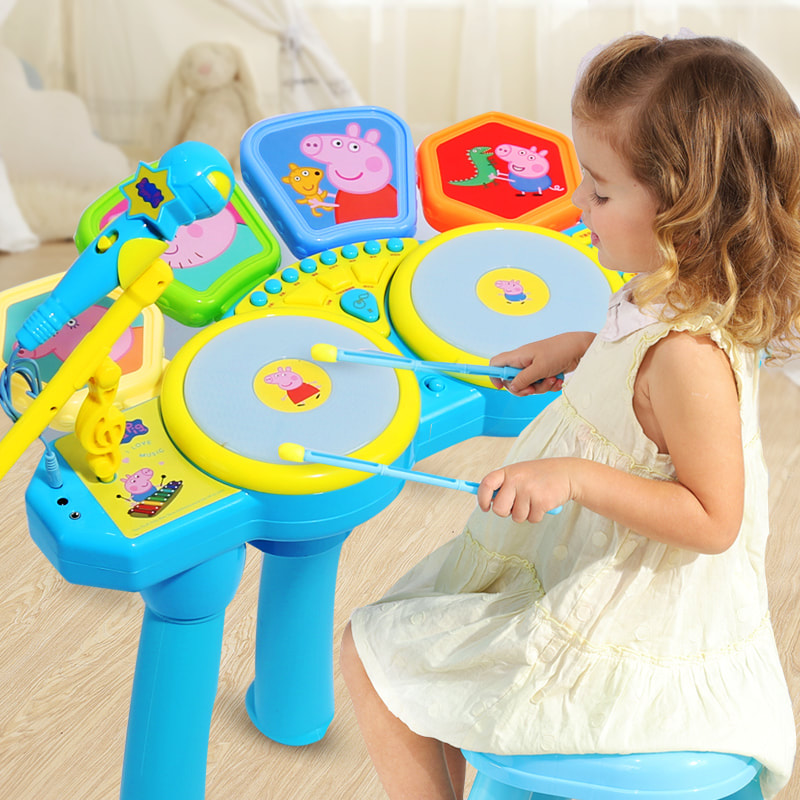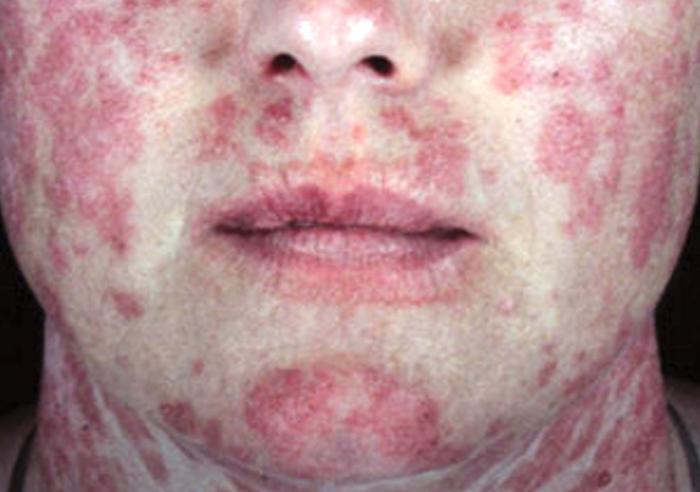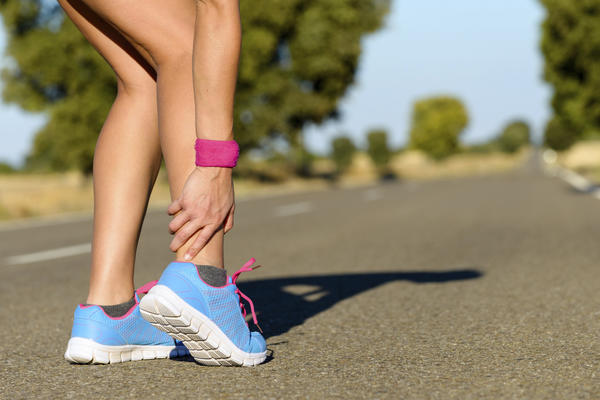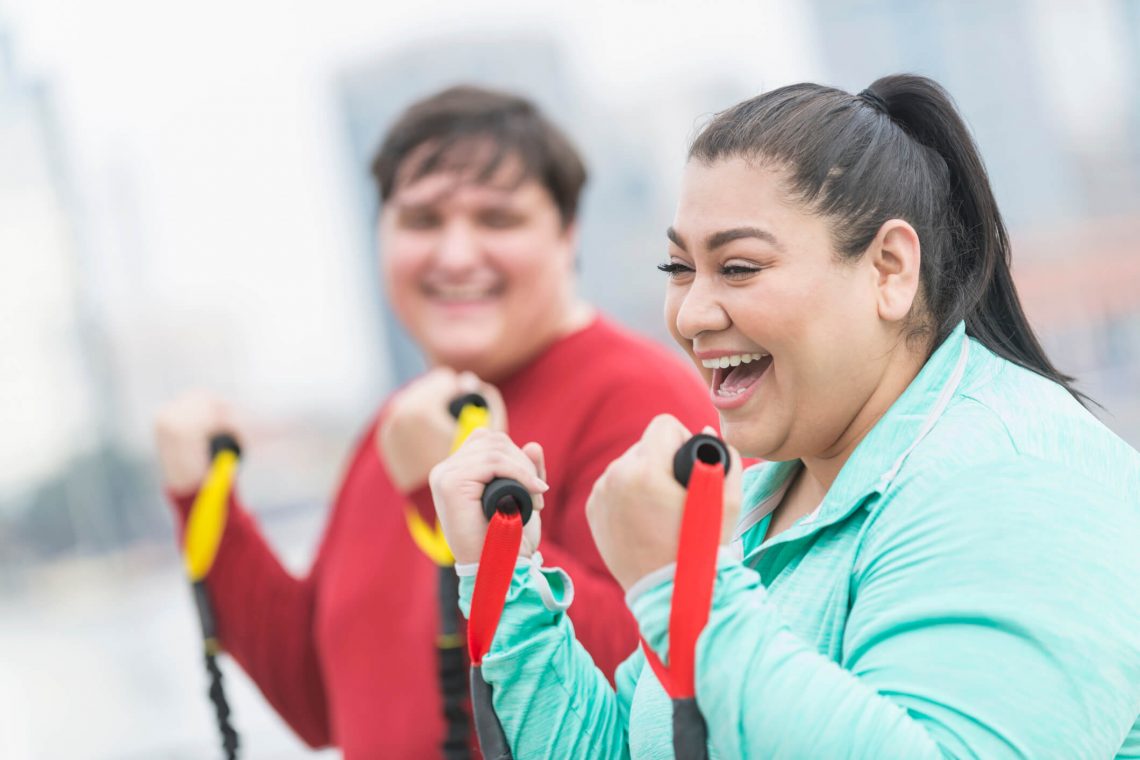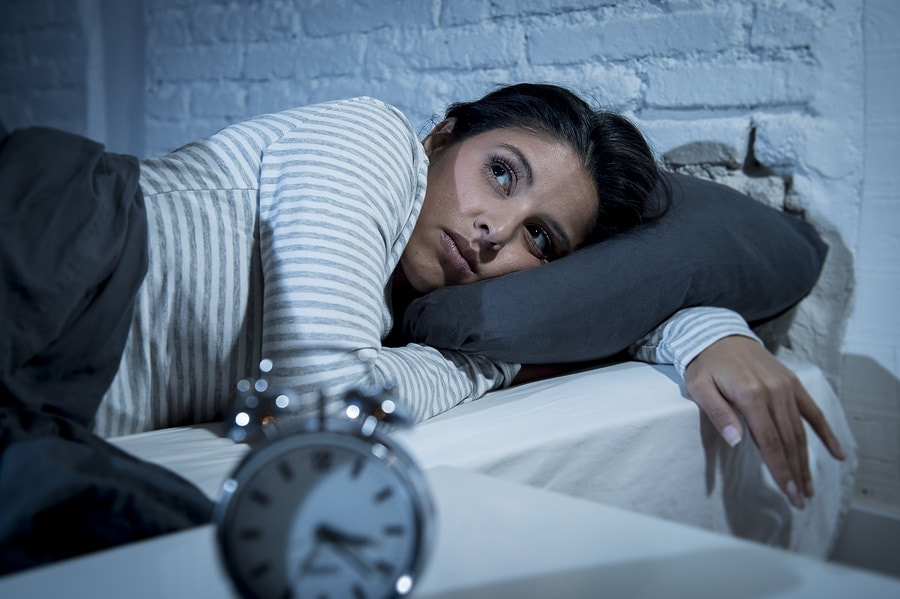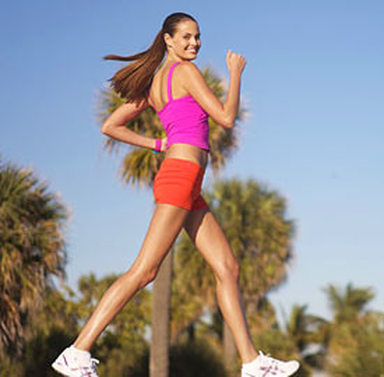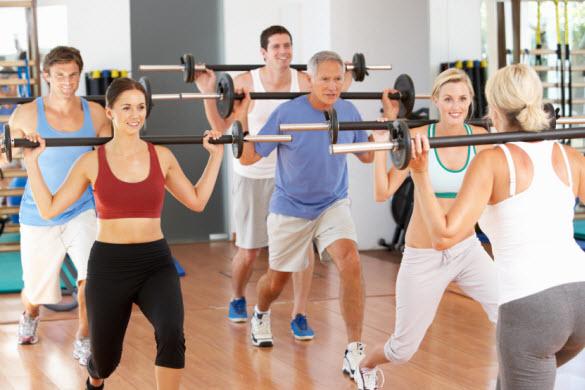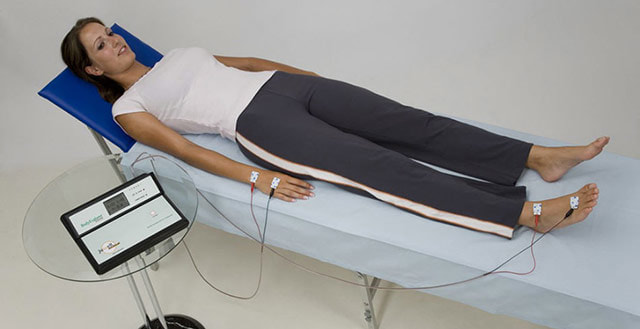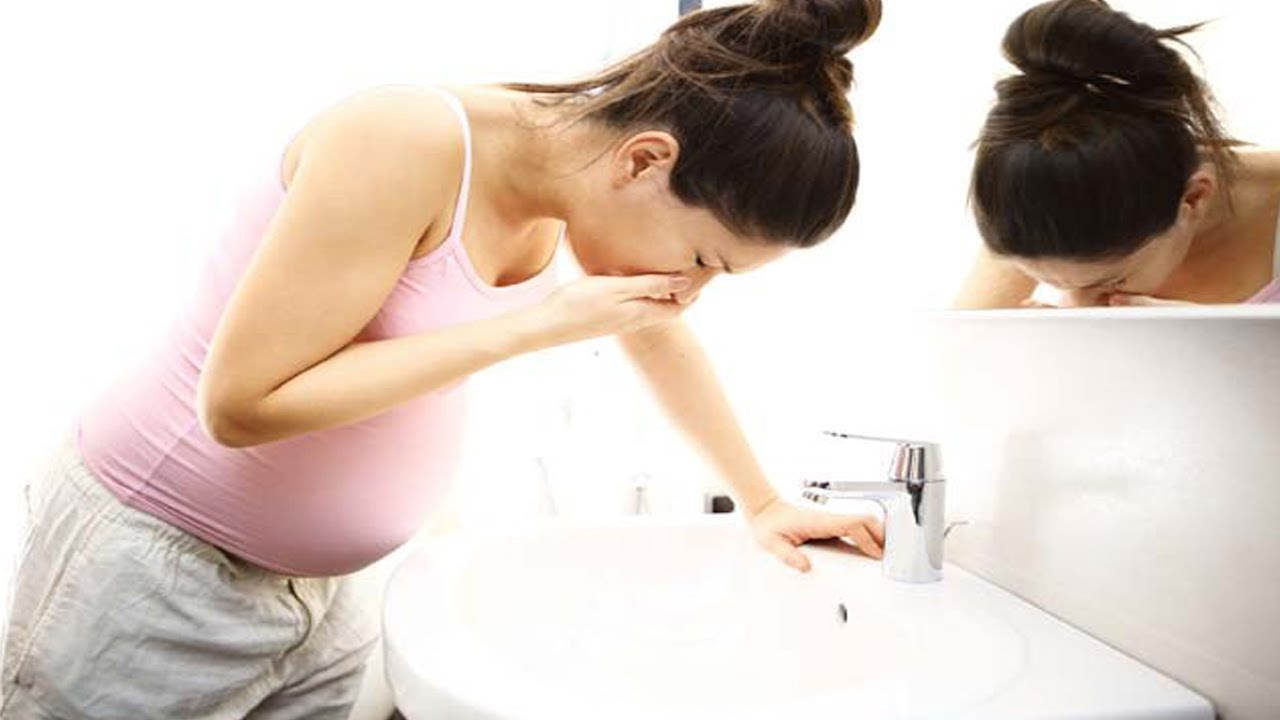|
Guys, especially teenagers, go crazy over muscle building and try following any advice that comes their way. An often-quoted one includes that, lifting weights breaks down a muscle which then grows stronger or bigger during the repair process. But, is this another myth or a reality?
Over-training to the point of fatigue definitely causes muscle damage, especially to the proteins that comprise muscle fiber. Two types of overload namely, metabolic and mechanical, can stimulate muscle growth. Metabolic overload is the quantity of work done by a muscle that depletes it of its energy supply. Mechanical overload primarily leads to structural damage of the actin-myosin protein filaments due to intense exercises such as weightlifting. The damage to the muscle causes the protein to synthesize new cells that are used to repair the damaged protein fiber. Proteins-Pillars of Support During/After Exercise
Do you find it harder to zip up your jeans and feel frustrated of putting on weight? There are more dangers lurking on every corner due to increase in belly fat than preventing you from wearing tight-fitting jeans or other fashionable attire! Fat is fair-it can manifest itself in any place in your body. It can make it impossible for you to squeeze your hands through a sleeveless t-shirt, make it harder to remove your finger ring or push yourself into a pair of your pencil jeans and so on. Figure-conscious individuals are worried over every single bulge or flesh protruding out irrespective of the place where it shows up. But, for physicians and health experts, there is one specific area where fat buildup is extremely dangerous and threatening. Belly Fat Most people associate an expanding waistline with aging which is truer in the case of women whose body fat shifts from hips, arms and legs to the abdomen after menopause. Generally, our body shapes reflect our genes and lifestyle. People accumulate fat in different places and this validates the existence of different body shapes such as pear, apple, hourglass and so on. The two most common ones are apple (weight gets accumulated in the midsection) and pear (bottom-heavy). Men tend to accumulate excess weight on their bellies (might be due to drinking too much beer too :D) while women gain more weight in their legs and bottoms. Post-menopausal women are fatter in the middle section not due to sheer coincidence, but due to decrease in estrogen levels that determine fat distribution in the body. This is also the time during which the risk of heart diseases becomes as profound as a man’s. Nutritionists, dietitians and physicians worldwide link fat around the mid-section with health defects such as heart disease, type 2 diabetes and certain forms of cancer. Weight in any part of your body is not got for health, especially abdominal weight. That’s because, the fat is not limited to the extra layer of padding right beneath your skin (subcutaneous fat) but also includes visceral fat which is located right inside your abdomen and sticking to your internal organs. From the outside, the extra layer of tyres surrounding our belly is the only one visible and the visceral fat lying deep inside is not clearly visible but impacts hard on your health. Impact of visceral fat is more pronounced because too much of this fat can produce substances that can raise blood pressure, impact good and bad cholesterol levels, boost estrogen levels and affect the body’s ability to use insulin. That’s the reason why we quote stroke, cardiovascular disease, type 2 diabetes and other health issues as the consequences of excess belly fat. Diabetes is a dangerous side effect as people lose sensitivity to insulin and the body is pressurized to pump out more. The increase in estrogen levels can elevate the risk of breast and colorectal cancers. There is even research showing that a waist measurement of 35 inches or more in women and 40 inches or more in men are risk factors for the disease. There are even other studies that show that even women with a normal BMI, but a larger waistline have an increased risk of dying of cardiovascular disease, cancer and other causes. Women are Victimized than Men A new study has found that accumulation of central adiposity (belly fat) may be worse for women’s heart health than men’s. Published in the Journal of the American Heart Association, it involved around 5,00,000 people (almost 55% of them were women) aged 40 to 69 years and living in the United Kingdom. Body measurements of these participants were taken and they were followed-up for a period of seven years. During this period, the study group tracked those individuals who suffered from heart attacks and found that, women who carried more weight around the middle were almost 10-20% at an increased risk of heart attack than women who were heavier all around. Weight around the middle was calculated using waist-to-hip ratio, waist-to-height ratio and waist circumference) and total body heaviness was measured using body mass index (BMI). The research also showed that:
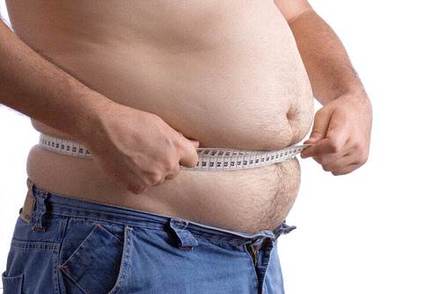 Measure Your Waist Circumference Accurately to Know Where You Stand Measure Your Waist Circumference Accurately to Know Where You Stand Measure Up! Slim or fat, low or high BMI, get your waist measured to see where you stand. BMI or waist-hip ratio can be useful, but your waist measurement indicates your belly fat to the dot! Measure your waist circumference with these steps: Step 1: Placing the measuring tape at the right location is crucial while measuring waist circumference. Place it around your bare stomach just above your hipbone, almost to the level of your naval. Step 2: Adjust the tape such that it fits snuggly around you without hurting your skin and ensure that the tape measure is level all the way around Step 3: Please don’t push in your stomach while taking measurements. Relax, exhale and perform the procedure. What we need is an accurate measure and not some measurement to prove anything to anybody Step 4: Waist circumference of 35 and above for females and 40 and above for males is an indication of pure trouble. Start exercising, follow a healthy diet and stay active to get lost of your belly fat. For any help, get in touch with an RDN at www.firsteatright.com who can help you with the right kind of diet and exercise charts to lose belly fat. Trim Down Given here are few simple ways to bring down your waistline numbers and stay fit: Maintain a healthy body weight: Every individual’s main aim must be to maintain a healthy body weight. Women are challenged after menopause as they pile upon extra kilograms despite the fact that they eat the same quantity and move around as before. That’s due to drastic hormonal changes, a decline in muscle mass (fat burns less calories than muscles) and lifestyle changes. It’s better that women close to their menopause age get their weights and waists measured and introduce small changes to daily routine that help them stave off the extra kilograms from piling up. Any RDN would recommend any individual that gradual weight loss stays for a long time than rapid weight loss that can slow down metabolism and pile up weights quickly. Move more: Regular exercising is critical for a healthy body weight and daily physical activity is recommended to keep your waistline in check. There is no mandatory rule that asks you to hit the gym to lose weight. Squeeze in activity whenever and wherever possible. For example, it might be a walk around your office after lunch or before you get into the car at the end of the day. It is advisable to workout at least for 150 minutes every week to stay fit. Try moderate activities such as brisk walking, hiking, gardening and bicycling and vigorous physical activities such as running, jogging, swimming or fast walking. Daily activity without diet changes may not help you lose weight but it helps you maintain a healthy body weight and improve blood sugar levels in people with diabetes. Mind your food: ‘Beer belly’ is a universal term and alcohol is most-often associated with an increased waistline. Avoid alcohol and other sweetened beverages as much as possible to prevent piling up belly fat. Eat more plant-based foods such as fruits, vegetables and whole grains. Substitute saturated fats with monounsaturated and polyunsaturated fats. Mainly, reduce portion sizes and cut back on calories to lose weight. An extra layer in your belly is a wake-up call to lose weight. When you lose weight, your body too prioritizes on losing belly fat and keeps it top in the list. Even if you lose only 5-10% of your body weight, you can be happy that you have reduced the dangerous layer of belly fat by as much as 30%. A flat stomach with toned abs might not be within your reach instantly, but you can be assured of a healthier body. 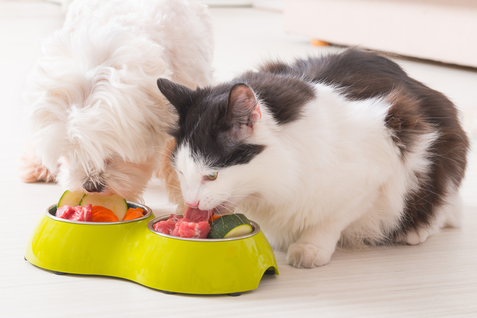 Cats Love Carbs & Dogs Love Fats Cats Love Carbs & Dogs Love Fats Dogs and cats occupy special places in our hearts and for some of us, they are our first love! Despite such care and compassion, sadly almost 80% of dog owners are under the impression that nutrition for dogs and humans is similar and less than 10% of dog owners are aware of the correct proportion of key nutrients their dog needs. Ask a pet owner and he/she would come up with umpteen reasons for loving his/her pet and the love is unconditional, unlike humans who have clauses and terms attached! They talk about incidents during which they had taken their pet for a vaccination, given a haircut or treated it for a cut or injury. Nowadays, there are even pet spas for those luxurious few! In recent times, I heard from one of my friends that her dog is obese and needs to shed a few kilograms to avoid complications such as diabetes and obesity-related diseases. Until then, diseases, illnesses and other disorders in pets had never crossed my mind! Poor creatures, if only they could speak to convey their feelings and needs! We follow the standard notion that dogs love bones and cats love to feed on fish and milk. If given a choice, what type of foods do these animals love to delve into? A study conducted shows surprising results and also negates the strong opinion that cats prefer and need a protein-heavy diet. Researchers involved in the study are frenzied over their discovery that could become a real challenge to the pet food industry. Dietary proteins are involved in different physiological functions such as blood clotting, hormone production and enzymes, vision and cell repair. It also has the maximum potential to make a person feel extremely satiated after which carbs and fats follow suit. The study involved 17 healthy adult dogs and 27 cats over 28 days who were fed with four different types of food that were designed to taste good equally. This cuts out any preferences and the animals tend to feed on foods that their body commands them to! This comes of the understanding from previous studies which proved that when animals were fed foods without any palatability balance, cats love to eat high levels of protein and dogs wish to eat more of fat. Once palatability is balanced, cats and dogs choose different macronutrient-based foods than what they would choose based on taste. Know your macronutrients, get a detailed information about each of them and learn about their impact on health from the website www.firsteatright.com. Choose Your Food The animals were given four different food choices: high-fat, high-protein, high-carbohydrates and balanced foods. Every day, dogs were given one hour during which they were allowed to eat all they can up to a predetermined calorie value. Similar strategy was followed in the case of cats too. Only difference was that, cats were given 24-hour food access until it reaches the caloric threshold. Care was taken even to change bowl positions daily to prevent ‘bowl position bias’. Results showed that:
Today’s canine creatures also follow masters and prevail as couch potatoes. If these couch potatoes are fed with foods high on fats and carbs, obesity and other problems are sure to crop up! The sedentary master puts off these pets from activities such as walking or ball game resulting in fatter animals with poor physical activity. How many times have we seen someone asking directions to some route to a woman or have we ourselves genuinely taken interest in requesting a lady for clarifying our navigation queries? Worst, even when a female is driving a car/two-wheeler, answers to our doubts are usually directed to the pillion rider, when the pillion rider is a male. This strongly invokes a sense of frustration and anger in us. It’s funny that men and women alike, misjudge all people to be the same and divert all their attention to the male co-passenger in directing them. But, are they misjudging people or is it true that men possess far better navigational skills than women?
Cognitive Difference Sex differences in cognitive skills start as early as the development of neuronal skills and lasts through an entire life span. Every year, pass percent of female candidates surpass male candidates in board examinations and girls top exam results too. Surprisingly, IIT-JEE results, CAT results and IPS/IAS examinations witness much better performance from boys comparatively. Likewise, common learning tasks show different performances from both, boys and girls. There is evidence backing the theory that males are better on spatial tasks and females in verbal tasks. What about navigation? Reroute your Routing Directions It is well-known that males perform better than females when it comes to navigation but there is no underlying connection established between navigation skills and one’s level of sex hormones in determining the reason. Actually, there are two different approaches involved in navigation-egocentric and allocentric strategy. While the former involves using landmarks and other such clues for directions, the latter includes distance, the absolute position of the landmark for finding the way out. Here again, men are better at using the allocentric strategy and women excel in the egocentric strategy for navigational purpose. Isn’t it true that we exactly remember the gym to be close to the ‘X’ accessory shop or the ‘Y’ restaurant? Men and women are on par when they try to outwit each other within an indoor environment without absolute directions. Once the navigation involves large outdoor spaces, men significantly outperform women! Recently, there have been studies and research happening trying to relate navigational skills of people with their risk of dementia. Game for It? Gaming craze hasn’t faded and isn’t in any rush to diminish too in near-future. Individuals are still stuck with their smartphone games and Sony Play Stations during all their free time. Companies are spending millions of dollars in developing interesting games for the youth of today and gaming has become one of the most-powerful and ‘in-demand’ market of late. If you would like to test your direction skills, the new smartphone game called the ‘Sea Hero Quest’ is the right one to pounce upon. The game challenges any player to sail on a global adventure to uncover precious artifacts (in the form of memories) which can be collected at different locations around the world. Men excel in navigational skills than women according to various studies and research. But men, please don’t be hasty and lift up your collar sleeves with a smug look on your face as I am not yet done fully. Actually, according to researchers at the University College London, this difference is primarily due to discrimination and unequal opportunities and has not got much to do with capability or talent. This comes as a result of a research test for dementia based on the game Sea Hero Quest that has more than 4 million players. Turn deserts into icy oceans and revive an old sailor’s old memory with a touch of a smartphone screen. What you see in the front is the game and its magic but what happens in the back end is what helps scientists garner data for their research. As you play, the game records the player’s navigational abilities and sense of direction, both of which are one of the primary skills lost due to onset of dementia. Being tech savvy is great maybe nowadays for both the end-user and the gaming company! Almost 2.4 million people have played the game since its launch and has helped to generate more than 9,000 years of lab data in such a limited period of time. The data showed differences in navigation abilities between men and women and amongst countries too. Countries in which men and women are almost equally treated showed very small difference in the spatial navigation test. Whereas, countries that treat women as inferior to men showed great differences in navigation abilities. Even the culture of people, their living style and traditions affected direction skills greatly. Getting lost or forgetting your way back home is one of the first symptoms of dementia and this game exactly tried to analyze the healthy age range between which people are able to use their navigation skills properly. One major belief that this study helped to falsify includes the fact that navigational ability declines only after a person crosses 60 or 65 years of age. This game helped scientists realize that a person’s ability to navigate declines as young as 19 (this was the age when researchers began sampling) and continues to decline forever. Data revealed that while players aged 19 were 74% accurate, the statistics sharply declined steadily reaching 46% for players aged 75. People in Denmark, Norway and Finland surpassed all other individuals residing in 189 countries in holding the world’s best navigational skills. It is also of importance to note that people of wealthier countries also tend to navigate the best. The research clearly indicates how navigation skills of people vary and change across age, location and other factors. In today’s world, individuals are diagnosed with dementia every few seconds and dementia is growing to become one of the greatest medical challenges faced by the world. The researchers also plan to take it forward by involving dementia-affected people in the game and figuring out their navigational skills. Get a complete picture about dementia, Alzheimer’s and Parkinson’s from the website www.firsteatright.com. Boys and girls, role up your sleeves and start sharpening your navigation skills! The term ‘virus’ has become more synonymous with computers, hacking and technology beyond its archaic role as an infectious agent. Viruses are submicroscopic parasites that do not have the ability to replicate on their own. Once they infect a cell, they replicate inside. Most viruses either have a DNA or RNA and the virion (infectious particle) contains the nucleic acid (this might be single- or double-stranded) and an outer shell of protein. Virus cause illnesses and infections that are controlled or suppressed by our body’s immune system with the help of our white blood cells called lymphocytes. These WBCs can identify quite a number of viral proteins that provide antigens and which cause an anti-inflammatory response. But sadly, not all proteins are able to play the role of antigens for anti-viral immunity. There might be a number of viruses but there exists only a certain number of proteins involved in lymphocyte verification of virally infected cells. Such reduced number of proteins lead you to trouble wherein the virus might go unnoticed by the immune system. These are the ones that can damage cells, cause strong infections and lead to a prolonged period of illness. We also term them as ‘stealth’ viruses as they have the strong potential to evade effective immune recognition and most primarily because they have been deceiving the medical community until now making themselves inconspicuous.
What makes viruses special is that they have their own genetic material and reproduce only according to their gene instructions but by using the host cell for resources. This typically shows the strong nature of virus to fight against hereditary diseases or cancer. Everything lies in the gene of the virus. You remove its gene and the virus becomes a dummy in the literal sense unable to replicate or trigger diseases. Not Alone All Along! Scientists and researchers had assumed viruses to target humans and infect them individually as lone warriors. What we have been missing until now (and this ignorance has cost us tremendously) is that they can form packs of up to 40 viruses and envelop themselves with a fatty sphere that makes them completely invisible to our immune system. But how did something that had been blinded from our perception for centuries together suddenly show up? When researchers at the US National Institutes of Health analyzed stool samples of patients infected by rotavirus or norovirus they were shocked beyond words when they came across this ‘groupism’ concept. Until now, viruses were believed to infect a cell, use this cell for replication and then burst out as individual viruses into the body. But, what took these researchers by storm is the fact that some of them were released as groups in spheres known as vesicles. These spheres act as armors to viruses and give them supreme power to attack humans. Firstly, these spheres prohibit/restrict the immune system from figuring out their presence acting as an invisible mask. Secondly, the spheres protect the viruses from destruction even from the most fluctuating/harsh environmental conditions such as stomach acid. Lastly, they enable enormous groups of these viruses to enter the target organs and create a dreaded scenario. When the researchers infected animals with a set of viruses that either existed individually or grouped as stealth spheres, they found that those creatures that were infected with vesicles were infected faster and experienced prolific symptoms compared to the rest of the population. Rotavirus remains the main culprit for diarrhea in children in the world and norovirus is extremely infectious and spreads instantly through schools, public homes and even through cruise ships. The researchers feel that targeting these vesicles and preventing them from forming in the first place could get us a solution for treating norovirus or rotavirus. Viruses causing common cold such as the poliovirus and rhinovirus can also cause stealth spheres. Stealth viruses have been found from the blood, cerebrospinal fluid, urine, throat swabs, breast milk, brain biopsies and tumor samples of patients suffering from allergic, neurological, psychiatric, autoimmune and neoplastic diseases. Every type of disease has a sub-list of commonly known infections and disorders attached to it and those details are available at www.firsteatright.com. Switching Gears: Disadvantage to an Advantage How about using these stealthy stealth viruses to treat cancer? That’s what scientists have been up to-redesigning adenovirus and using it for cancer therapy. In general, the adenovirus can easily be neutralized of its power by the immune system and eliminated by the liver. The researchers involved in the study rebuilt viruses to infect tumor cells using molecules that act as the bonding agent between the tumor cells and the virus. Next, the virus was blinded off the immune system using a protein coat. This required some smart action as the virus should not only be off-limits to the immune system but it also shouldn’t be flushed out of the liver as the liver normally removed unmodified adenovirus from the bloodstream. The viral gene redesigned using protein engineering techniques efficiently shuttles infected tumor cells in lab-tested animals.  Interaction Makes Way for an Everlasting Mom-Child Bond Interaction Makes Way for an Everlasting Mom-Child Bond Parents struggle to give their children the best things in life, starting from an infant’s toys and games ranges. What started during olden days as a means of pastime and a chance for a beautiful friendship to blossom between strangers has now ended up as a motivational factor for finetuning children minds, gearing them up in this competitive world to outperform other kids and as a means of enriching a small one’s mind to think big. Our minds are constantly boggled with ads for toys that will make our kids happier, smarter and successful. Such toys include sophisticated technology use, reach numerous people with its advertising gimmicks and are often expensive. Above all, the idea might be a copy of the latest edition of a popular video game or a movie. These kinds of toys rarely meet their purpose of making kids happier, smarter and successful. The idea still remains simple from the child’s perspective-give any new toy to a kid and you have got a happy kid as children aren’t usually choosy about toys. But, parents must be choosy as toys are something more than a mere plaything. Toys are for fun, but they must also be safe, age-appropriate and stimulating. Parents must regard toys as a learning tool for development and improvement. Apt to the proverb, ‘All work and no play makes Jack a dull boy’, play is integral for the social, mental, physical and emotional development of children. If you are unsure about the benefits of outdoor play or ignore sending your kids out to play in the breezy weather, visit the website www.firsteatright.com for complete information. Toys can mainly be categorized into three types for nurturing a child’s brain: Toys that invoke a child’s imagination and make him/her use the toy in ample different ways of play: The toy helps to get things started and from thereon, it depends on the child to use the toy in different ways. The child needs to set his/her minds thinking and come up with creative ideas to put the toy to best use. Lego and video games are overpowering such imagination-tickling toys and this can affect the way in which a child learns and thinks. Few toys that are bound to spur up your child’s imagination skills include:
Toys that serve as a foundation for interaction, especially with parents and caretakers: A strong parent-child relationship can greatly impact the emotional health of children and lay the foundation for more crucial things in life. A free-flowing interaction between children and adults are responsible for building connections in the brain and when a solid emotional health of the child is well-established, it pays off in the long run as such children are less likely to have sex early or get into trouble. This makes it essential that you buy toys that you can share and play with your child. Some of the above ones such as wooden blocks, pretend-play toys and other stuff offers you with ample opportunity to bond with your kid while playing. Some more solid ideas include:
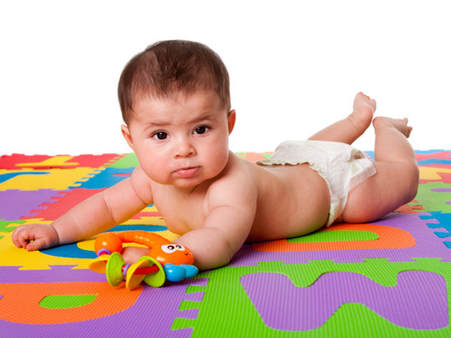 Toys that Pave Way for Strong Finger Grip are Loved by Infants Toys that Pave Way for Strong Finger Grip are Loved by Infants Age-appropriate Games It is always better to have a competitive edge over any business and toy business is no exclusion. Educational toys and CD’s business are booming as they use the parent’s fear and anxiety to mint money. Also, parents make a great mistake of keeping all sorts of toys in front of their children’s eye. Exhibiting too many toys at a given time can confuse the child. It is necessary that parents keep only a selected few out at one point of time and keep rotating toys to reintroduce a toy every few weeks so that it feels new and fresh in the child’s mind. Some toys such as wooden blocks have the power to carry a child through different developmental stages and one should never rush to replace such wonderful stuff with something newer. An infant initially learns to grip and hold a block which promotes muscle development and coordination, as a child grows the blocks kindle a child’s imagination, creativity and building principles and finally, sharing these blocks with others teaches the concepts of tolerance and cooperation. Kids love toys that suit their age. Given here are a list of toys that suit kids as they go through different stages of development: 0-6 months: Visuals, colors and movements attract infants at this age when they are busy discovering themselves, working on eye-hand coordination, reaching and grasping. Rattles and any toy that can help the infant grasp, swipe, kick, pull or shake can serve this purpose. 6-8 months: Older babies can hold small toys. At this stage, babies try repeating activities and actions in order to master them and love to transfer toys from hand to hand and into and out of containers. Infant toys will be used in a different way by older babies. 8-18 months: This is the time during which toddlers start enjoying pretend-play toys. It is the ideal time to introduce doctor sets, kitchen stuffs, toy cars, trucks and school buses. 2-4 years: Preschool years teach valuable socializing lessons to children and these kids continue to do more and more of pretend play. Miniature farm sets, Play-Doh, large crayons and finger paints stir a child’s creativity, Lego toys, blocks and puzzles develop fine and gross motor skills and also construction toys and ones that make noises such as drums fascinate children and prove to be the perfect choices for kids in this age group. Many of us workout and stay active between hectic work schedules. Aren’t we entitled to benefit maximum from the fitness classes with the minimum time we invest? For every individual who desires to maximize fat loss, weight loss, strength and overall performance, swapping out a few exercises and bringing in few other exercises helps maximize output.
Swap Out Crunching Exercises Although every fitness-minded person advises doing abdominal crunches for belly fat reduction, these crunches do very little in terms of burning calories and fat. These exercises help improve strength and muscle tone of rectus abdominis but do very little to reduce fat. For fat reduction, one needs to perform few other cardiovascular exercises and follow a specific diet. Also, as the crunching position almost replicates the ‘hunched’ sitting position that is the root cause for lower back pain problems in many people, it is better to avoid it. Bring in Planks & A Wholesome Diet Before entering the gym, enter your kitchen to modify and correct your diet plan. Eat light, eat often, limit sugar and processed foods, eat more greens and lean protein and drink water. Such lifestyle changes store minimal fats and maximal abs. Plank is a good way to strengthen abs and integrate core muscles. You can also rely on exercises such as chops and carries to strengthen the trunk muscles without causing harm to the lower back. Swap Out Single-joint Exercises Single-joint exercises apply pressure on a single joint and muscle through their postures and devices. Bicep curls, triceps extensions, crunches, shoulder raise and leg extensions are examples of this. It does not mean that you need to stop performing these exercises. It only means that performing such exercises is not full-fledged time utilization as only a small portion of the muscle is targeted while performing these exercises and fat loss is impossible in such cases. Bring in Multiple-joint Compound Exercises Exercises such as squats, push-ups, lunges, deadlifts and pull-ups integrate multiple muscle groups and joints that pave way for increased muscle growth and fat loss. Cut Down Increased Resting Time Between Sets For some programs, excessive rest between sets is mandatory while for some other programs where time is restricted, resting for more than 60 seconds between sets is not needed. If you feel that you are able to perform an exercise with less than 30 seconds of resting periods, increase the difficulty level of the exercise. Minimize time spent fidgeting with your phone, looking at yourself in the mirror or chatting with your workout groupies between exercise sets as these prevent you from reaping maximum advantage from your physical activity performance. Bring in Supersets Supersets are exercise sets that focus on opposite muscle groups performed successively with little-to-no rest in between. A set of 10 push-ups and 10 pull-ups are called supersets. Such exercises help utilize your time to the maximum extent possible and bring about maximum fat burning and muscle building within the given time. Swap Out Low-intensity Cardiovascular Exercises Walking slowly on a treadmill for an hour at a low heart rate is not going to benefit you in any way. We exercise at 50-70% of our heart rate max when we perform low-to-medium intensity cardiovascular exercises which is good for amateur exercisers, endurance athletes and those with certain physiological conditions. It takes more than 30-60 minutes of training each day to see results in such exercise forms. Bring in High-intensity Cardiovascular Exercises Try running as fast as you can for 1 minute followed by walking for 1 minute repeating this cycle for the maximum time your body permits you to do it. High-intensity cardiovascular training follows this policy of exercising rapidly followed by mild exercise. These result in 80% and above heart rates and help to burn more fat in less time. High-intensity exercises change the cells, muscle and metabolism in limited time compared to low-intensity or moderate-intensity exercises. Utilize your precious time involving yourself in exercises that give your rapid, safe and maximized results. Practice these exercise swaps to optimize your workout time benefits to the maximum extent possible. Along with your workout, it is essential to maintain a healthy well-balanced diet for ultimate fitness. Get in touch with acclaimed nutritionists and dietitians at www.firsteatright.com to get in shape and stay fit. A foodborne disease, listeriosis is caused by the bacterium Listeria monocytogenes and rarely by bacterium Listeria ivanovii which is different from other germs because it can grow even in cold temperature, including the refrigerator. This bacterium was recognized as a major foodborne pathogen in the latter part of the 20th century.
Foodborne listeriosis is one of the most serious and severe foodborne diseases but a rare occurrence. It affects only 0.1 to 10 cases per 1 million people every year region-wise. When the occurrence is so rare, what makes it so dreadful is the high death rates due to the infection which makes it an important public health concern. Sources Foods that cause listeriosis mainly fall under two categories:
High-risk Category Though not age-specific, this disease primarily affects newborns, pregnant women, elderly people and adults with weakened immune systems. Healthy people are the rarest of the rare to be affected by listeriosis.
It is possible to minimize your risk of food poisoning by ensuring certain things.
When diagnosed at an initial stage, listeriosis is easy to treat. Antibiotics are generally used to treat this illness and infections during pregnancy should immediately be dealt using antibiotics to prevent infections of the fetus or newborn. A Major Foodborne Illness in our Country Listeria monocytogenes are the second deadliest foodborne microbes after Salmonella. Developed and under-developed countries have decreased awareness of the disease. Ready-to-eat foods have become an indispensable part of our lives and hence, acquiring the bacteria Listeria is inevitable. Power cuts are also regularly seen across the entire nation and refrigerating foods at a particular temperature continuously in these conditions is impossible. Produce such as cabbages, coriander, broccoli, cantaloupe, watermelon and apple are said to contain maximum pathogens. In such conditions, we must take extra care to follow the suggestions mentions above to minimize risk.  Staying Fit is Not a Ritual, It's A Way of Life Staying Fit is Not a Ritual, It's A Way of Life We hit the gym, enroll in cross-fit classes, learn Zumba or do aerobics. If one answers genuinely the motivation behind all these physical activities, there is something more than the underlying answer that is simply fitness. The Real Motive Behind Physical Activity People talk about fitness and propaganda their healthy lifestyle solely not for the sake of living healthy. Most people don’t love fitness only for the sake of fitness and there is a bigger motive behind all their self-induced motivation. Fitness is a gateway to explore things we love, maybe a game of football, sway our body to the Zumba dance or swim few laps in the cool water. Fitness is often seen as a means to the end. For example, we enter college not for the sake of studying but with the intention of landing up with a great job. But, we often project fitness as though gaining knowledge is the sole purpose of enrolling in college. Every person’s intention differs. Most do physical activity to lose weight, some do it to make themselves fitter for engaging in activities such as volleyball, stand-up paddle boat, hiking or mountaineering that require high energy levels and stamina while others do it just because the entire society does it (to ensure that they are not singled-out in a crowd). When an obese person wishes to lose weight, the main point of discussion remains about losing certain kilograms rather than the benefits of the outcome such as a leaner and fitter body, decreased risk of diseases and a positive frame of mind. In practice, the obese person himself/herself would only look at the number of kilos that can be lost and not on the actual health benefits. For instance, once an individual was denied entry to a ride in an amusement park just because he was obese and not suitable for taking up the ride. This utterly disappointed his much-excited son and then the dad decided to lose weight. The motive of this person is to be able to take up the amusement ride rather than reducing weight for the sake of fitness. Actually, this kind of motivation keeps the person move forward strongly and achieve his/her goals. If we find ‘why’ to the fitness question, half the problem is solved and the weight loss journey is sure to happen successfully. Obese/overweight individuals wanting to lose weight can get in touch with a registered dietitian nutritionist at www.firsteatright.com. 100% or 0% Only when it comes to fitness, we all become perfectionists. Getting late to office on some days or missing out on our favorite TV series do not motivate us to quit our job or stop watching the series. But, we do exactly this with fitness. When a person following a healthy diet plan goes out for the weekend, he/she might drink and party. This might demotivate the person and he/she struggles to resume healthy habits and working out. The person might feel dejected, bloated, lethargic and sluggish to resume any activity. What the person misses here is that, if eating and drinking for a couple of days can make him/her feel bloated, resuming healthy food habits and exercising is also going to cause a positive impact on the person’s body. Our body is surely going to respond to the wise food choices as quickly as it responds to the unwise food choices. Instead of grumbling about the past off-the-track activities, start focusing on the positive choices and habits right away. Each Person is Gifted with Different Capabilities People might be good at handling multidirectional family responsibilities, exceedingly competent in their professional field or might successfully pursue their favorite hobby, but when these people are asked about their interest and dedication towards fitness, they are at a loss of words. The passion in an individual’s eyes when he/she speaks up about his/her favorite activity or job is unmatchable, lively and energetic. What the individual does not realize is that fitness too takes up the same characteristics to become successful with it. Once these people realize this, their mindset changes and they approach fitness in the same positive way in which they approached their job too. A single workout is not going to turn a person’s life upside down, but a single conversation can change the person’s approach to a problem upside down. Once the individual gets the knack of the workout phase, he/she is sure to continue the journey of fitness forever. The world would be a beautiful place if all of us got the opportunity to do the 9-6 job! Alas, that’s not how we are meant to function as per our demands and wishes. Even if such a scenario existed virtually, then what about security, law and order, emergency hospital cases, safeguarding lockers and banks and ultimately, our job commitments? Call them black sheep, scape goats, exceptional cases or by any other name, there are a handful of people in every sector who dedicate their knowledge as well as a share of their health in fulfilling job requirements. Many of us or our friends regularly do night shifts due to work commitments or lust of extra pay. But, the price we pay for this cannot be compensated.
24×7 Work Support We are turning out to be a 24*7 society with about 15-30% of the people working outside business hours amongst which almost half of them do night shifts. Try to get a night-shift worker’s opinion on health and concentration, any of them would instantly reply that night shift work compromises cognitive capability, contributes towards insufficient sleep and rest and leads to numerous health problems such as sleep disturbances, gastro-intestinal disorders, cancer and metabolic disorders such as obesity, metabolic syndrome, cardiovascular disease and type 2 diabetes. Any shift job, especially night shifts can be a challenging task for people with diabetes as the haphazard routines can affect both mealtimes and medication schedules. The different shift schedules can affect the individual’s ‘body clock’ due to varying sleep patterns. The circadian rhythm regulates metabolism and any changes in this rhythm can increase the risk of type 2 diabetes. Our body has an internal body clock that adjusts itself according to daylight and darkness and shift work can alter this clock due to changes in the time you eat, sleep, stress levels and other physiological changes. All these can affect blood sugar levels which causes problems with both hyperglycemia (too much blood sugar) and hypoglycemia (low blood sugar). Shift Work Affects People with Type 2 Diabetes A new study finds that people with diabetes who work night shifts have poorer control over their blood sugar levels than those who work in dayshifts or are unemployed. The researchers analyzed data of more than 270,000 individuals in the United Kingdom and found that those who worked irregular or rotational shifts that included night shifts were 44% likelier to have type 2 diabetes than others who worked regular hours. This is also one of the first studies to show a positive association between number of night shifts and the associated risk of diabetes. For example, working night shifts less than thrice a month increases the risk of diabetes by 24% whereas working night shifts more than eight times a month increases the risk by 36%. The surprise element here is that individuals doing permanent night shifts were not at an increased risk of type 2 diabetes maybe because they adapt their sleep-eat routines as per night shift requirements or they were naturally ‘night owls’ who could stay awake all night. Nothing is Impossible You have got a job and that’s great news in this recession-filled markets these days. But, you must work on midnight shifts which keeps you doubtful about pursuing the job. Sometime back, shift jobs were a pain for people on insulin and diabetes pills. Modern science and advancements have given us with ample opportunities including rapid-acting synthetic insulins which function as closely as what insulin in the pancreas normally does. After all this, even when your diabetes is under control, it is likely that you might suffer from bouts of lower blood sugar levels despite taking insulin or certain diabetes pills. That’s mostly because of mental and physical stress due to shift work that has a strong impact on the body’s circadian rhythms. Once you are definite about your night shifts and cannot avoid it by any means, it is better that you reduce health risks by eating a healthy diet, maintaining healthy weight ranges and leading an active lifestyle. Plan Your Meals Any shift work can disturb mealtimes and make meal planning a difficult task. Despite hurdles, snacking on healthy foods and sticking by your shift, meal schedules can help to keep diabetes under control. Try to prepare most of your meals at home as this ensures you of nutritious foods. Such meal preparations require advance planning which can be done over the weekend as it also becomes easier to purchase the required ingredients too. Also, breaks and snacks are important for all, especially for those on diabetes pills and insulin. Rather than buying some empty-calorie snacks to munch from outside, it is greatly appreciated if you can carry some healthy snacks such as sprouts, fruits or salads. It is always better to get the opinion of specialists such as registered dietitian nutritionists (specializing in diabetes) at www.firsteatright.com who can help to plan your meals and snacks keeping your health foremost in mind. Physical Activity Keep physical activity schedules outside work hour routines. It might seem awkward initially to workout mid-afternoons or early evenings, but it is always better to work out sometime of the day than to stay idle. Try various permutations and stick to the new schedule that best fits your daily routine. Such daily exercises are not only good for your glucose levels but also work great on your heart health and mental health too. Sleep The worst-affected daily routine due to irregular work timings is sleep. Night shifts can throw your sleep routines off track and totally collapse sleep quality. Such disturbed sleep can impact sugar levels and conversely, also high or low blood sugar levels can have a strong impact on sleep. Some tips to improve your sleep include: Avoid stimulants such as drinking caffeine drinks, smoking, exercising or doing strenuous housework as all these tasks can have stimulating effects on your body. When such activities are performed right before hitting the bed, it can disrupt sleep and make it difficult for you to fall asleep. Prepare your sleeping room to be dark, devoid of sounds, serene and such that you are likelier to fall asleep quickly. You can buy a sleep mask or ear plugs to cancel out any noises. Don’t use electronic gadgets before bed as it can confuse your brain whether it is daytime or nighttime. By staying away from all other activities except lying down on your bed, you are sure to drowse off into sleep. Practice relaxation techniques such as meditation to keep your mind at peace and improve your sleep quality. Even for people without diabetes night shift can strain a person’s health. All shifts create strain, but nightshifts are the worse and the most stressful time to work. Forward-moving rotational shifts (morning-afternoon-night shift cycle) that happen every 2-3 days are better than ones that change from night-afternoon-morning shifts. Whatever shift you might work, never miss on your rest and activity schedules. Sedentary postures, smoking, drinking alcohol, eating junks and inactive lifestyle factors cause harmful effects on the human body. Latest research shows that sitting might be more harmful than smoking these days! High-intensity exercises have been glorified by fitness experts and people alike, but numerous studies have changed our perspective and shifted our passion towards moderate-intensity exercises as they are linked to lower occurrences of heart disease, cancers and other illnesses when practiced regularly.
Walking is still the best form of moderate-intensity exercise as it’s easy, free, independent of external factors and requires only a comfortable pair of shoes and clothes. Most of us have been walking since we were one year old and we need no help in getting up and going for a brisk walk down the street or park. Ironically, walking is not as easy as it sounds to everyone living across the world. It torments some people irrespective of their age due to certain illnesses or health conditions that cause voluminous leg pain after walking. Conditions such as arthritis that cause knee and hip creaks are common and well-known, whereas others such as periphery artery disease are not. Let’s look into the unfamiliar and unexplored conditions that can cause pain after walking, and also solutions to reduce the overall pain and ease the process. Peripheral Artery Disease Peripheral artery disease is one form of atherosclerosis that has the ability to cause strokes or heart attacks. Here, arteries become narrowed due to fat and cholesterol-filled plaque and these are the same arteries that supply blood to the leg muscles. The person experiences cramping in the buttocks, thighs, calf (most common) or foot due to insufficient blood flow from the arteries. This pain is due to the worked-up muscle cells that are deprived of oxygen supply due to restricted blood flow. When such people walk, the pain shoots up drastically and stops not until the person stops walking and slowly diminishes with rest. The risk factors are similar to heart attack and stroke-smoking, high cholesterol levels, high blood pressure and diabetes. Common signs of this disease include a diminished pulse below the narrowed artery, bruises and scratches in the lower leg that don’t heal and pale/cool skin. Peripheral artery disease by itself is a serious one, but this can be an indication of a much more serious and complex problem such as heart attack, stroke or transient ischemic attack. These people are 6-7 times likelier to be affected by such serious health problems. Trying to walk ignoring the pain will not show any positives effects on these people. What they need is a professionally structed exercise program that motivates them to walk (even if it is only for a few minutes) until pain erupts, rest until the pain goes off and then walk again. Such sessions serve to be useful if individuals do it for at least 30 minutes on as many days as possible in a week. Physicians prescribe low doses of medications to relieve pain sometimes. Certain people experience pain even during rest, mostly in the feet. When pain does not reduce even after exercising and medication, the doctor might suggest surgery to reopen the blocked artery. Chronic Venous Insufficiency This too deals with improper blood flow just like peripheral artery disease but involving the veins and the blood flow back to the heart and lungs. Arteries are active participants and veins are the passive ones in blood flow. In this disease, the blood remains circulating in the legs and feet without travelling back to the heart. Swelling and inflammation of the skin and the connective tissue underneath it are typical symptoms. Legs seem to ache, there is extreme pain in the groin or thigh while walking and this pain takes longer time to subside with rest than in the case of peripheral artery disease. Pain is usually relieved by lying down on your back and using a pillow to raise your legs such that blood flows back to the heart. While sitting too, moving your toes up and down several times can flex the vein-pumping leg muscle. Intense pain is curbed with compression stockings or surgical procedures. Varicose vein treatment procedures have drastically improved where the affected vein is permanently closed instead of being removed from the body. Lumbar Spinal Stenosis Stenosis is the medical term to indicate any kind of narrowing. Spinal stenosis can happen anywhere in the spine and the pain is due to mechanical pressure and the lack of blood flow to the nerves. Lumbar region of the spine forms the small of the back and spinal stenosis in this region is indicated by lower back pain, but it is mostly the legs that are affected. Similar to peripheral artery disease, the individual experiences cramping tightness in the thigh that increases with walking. The legs seem to be weak and numb. Diagnosis involves reading medical history and discussing symptoms. The physician usually asks whether the pain eases when the back is curved forward or flexed as this posture relieves pain in the lumbar region. An MRI or CT scan is often taken, and imaging studies are most unlikely to be performed for checking out this problem. Physical therapy and exercises are taught to relieve pain and strengthen the back. When pain becomes unbearable medications are prescribed and surgery remains the last resort when there is persisting pain. Diabetic Neuropathy People with diabetes often suffer from nerve damage or neuropathy and the actual reason behind this is still unclear. Increase in sugar levels damage the tiny blood vessels that supply nerves leading to nerve strokes. Diabetes also depletes the body’s store of neurotrophic peptides, chemicals that repair and regenerate nervous tissue. Both, the upper and lower leg can be affected by diabetic neuropathy. In the upper leg, pain is mostly felt only in one leg and in the lower leg, symptoms include numbness and tingling in both legs equally. Such numbness can leave sores on the feet go unnoticed which further worsens them, especially when the individual is a diabetic. The problem can be avoided by maintaining blood sugar levels but there is no evidence supporting improvement in individuals who maintain their sugar levels once the nerves have been damaged. Staying on a healthy weight and following a well-nourished diet help to maintain blood glucose levels. Individuals interested in taking up a healthy diet can get in touch with reputed dietitians/nutritionists at www.firsteatright.com. Walking with diabetic neuropathy is difficult, but symptoms improve with exercise. Medications are sometimes prescribed to reduce pain. Relationships are beautiful: mom & daughter, father & son, best friends, lovely sisters/brothers and above all husband and wife! The kinship between parents and children are irreplaceable, but couples share something special and unique that can never be replaced or compromised. Sadly nowadays, many marriages end in divorce or separation for reasons unknown, though many of them are easily avoidable, solvable or acceptable from either side! Individuals nowadays are not ready to compromise on anything-right from their meal to careers to life partners! If something does not seem right, we tend to replace it immediately without giving a second thought about mending or correcting it. Even children nowadays want the best of everything and parents are not ready to settle for anything less than the best for themselves and their kids.
Some couples offer couple goals to the world according to some of our newspapers and media! What exactly are these couple goals? Finding time whenever possible and meeting each other, although it is going to be just for a few hours? Taking candid photographs and posting it on social media with creative sentences and hashtags? Relentlessly taking efforts to buy the best of things for your better-half? Yup! All these things make our lives beautiful, some kind of a musical story! But there is something more to this-love, compassion, understanding, compromising, realizing each other’s needs, not crossing over each other’s private space and above all, standing by your spouse through the thick and thin of events, things and everything else. Psychological & Physical Health Marital status is associated with both psychological and physical health and when a marriage ends in divorce, one of the ways it affects health is through health behaviors such as smoking, drinking and exercise. A new study by the University of Arizona shows two prime factors affecting a person after divorce-a greater risk of increased smoking behavior and decreased efforts of physical activity. The research was a long-term study of healthy adults aged 50 years and above. The data from these participants were collected every two years starting right from 2002. A total of 5,786 people participated in the study out of which 926 of them were divorced/separated and the remaining people were married. The data collected included details about life satisfaction, exercise frequency, smoking habits, the participant’s level of inflammation and lung function. Results showed that:
The results are clear and the moral remains unaffected, still we don’t get an answer as to WHY divorce leads to increased smoking rates and decreased exercising. The research team feels that one possible explanation would be that, divorced/separated individuals don’t have a spouse who holds them accountable for their health behaviors. For example, if one of the spouse smokes and the other doesn’t, one might try to influence the other’s behavior. But, when relationships end, we lose this connect and control of our health behaviors. Also, divorce/separation does not end up in negative health consequences all the time. On the contrary, it might even improve the quality of life of individuals who have come out of/terminated their unhealthy/unhappy/tormented relationships. Death of a spouse takes emotional agony to the next level and the consequences are grave in some cases. Discussed in www.firsteatright.com are few such situations and solutions to lessen your melancholy and move forward in life. People who brood over their separation/divorce should never be left without asking these two critical questions:
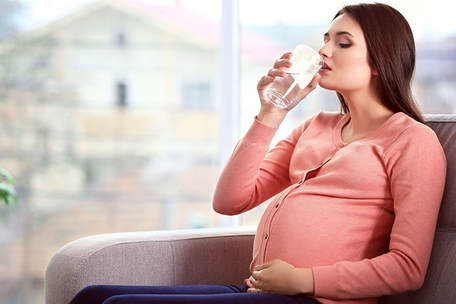 Consume Adequate Water to Avoid UTI Consume Adequate Water to Avoid UTI Stroke is a life-threatening serious medical condition in which blood supply to the brain is cut off. It is a brain attack that causes long-term disability. Stroke can affect anyone at any age and although stroke during childbearing years is rare, it can be annihilating when it attacks the pregnant woman who is filled with dreams of starting a new family. In fact, there are several causes of stroke that are specific to pregnancy and the postpartum period-preeclampsia, eclampsia, amniotic fluid embolus, postpartum angiopathy and postpartum cardiomyopathy. Infection Becomes a Risk Factor for Stroke A new research says that pregnant women who have an infection when they enter the hospital for delivery are at a great risk of having a stroke during their stay. The research analyzed whether infections contributed to stroke risk during peripartum (shortly before or after childbirth). Although maternal strokes are rare, only about 30 out of 1,00,000 pregnancies, mortality rates are tremendous. The research was carried on large-scale involving 2.8 million women who were hospitalized for delivery between 2007 and 2011. Contained among these women were 455 patients who were victims to stroke during the hospitalization. Results showed that:
Preeclampsia-related Stroke Confined to pregnancy, this condition is characterized by high blood pressure and affects almost 5-8% women in their pregnancy term. Women with preeclampsia are at a higher risk of stroke during pregnancy and after delivery, especially when they have urinary tract infections, chronic high blood pressure and bleeding or clotting disorders. In yet another study of women who were hospitalized between the years 2003 and 2012, researchers identified 88,857 women with preeclampsia out of which 197 were affected with pregnancy-related stroke. The irony here is that more than 1 in 10 of the preeclampsia-related strokes were fatal. Women affected by preeclampsia and pregnancy-related stroke were 3 times likelier to suffer from infections when they arrive at the hospital or 7 times likelier to suffer from severe preeclampsia. Although preeclampsia is a common disorder, many people are not aware of its association with stroke. Women, especially in their postpartum period, must take any neurological symptom, including severe headache, seriously. Obesity/overweight is a major epidemic worldwide ruining the well-being of individuals due to its effects on health. Cardiovascular diseases, high blood glucose and blood pressure levels, knee pain and infertility problems are all results of carrying an overweight body. Lifestyle, activity levels, exercise schedules, diet and stress levels prevail as major determining factors of a healthy-weighed body. Recently, activities of gut bacteria are also said to have a lasting impact on obesity rates of a person. There are numerous studies and research pointing to the fact that obese/overweight adults are at a higher risk of dying from heart disease or other illnesses, greater the obesity rates, greater is the chances of death and so on.
Healthy Obesity The term ‘healthy obesity’ sounds more like an oxymoron and brings us to the point whether a person can be obese and healthy at the same time. A BMI above 30 is termed as obese and majority of the researchers/scientist population agree that the term ‘healthy obesity’ is flawed as obese yet metabolically healthy people are at an increased risk of health conditions such as type 2 diabetes, chronic kidney disease and overall mortality rates. There are studies that show that metabolically healthy obesity is not a safe condition and even women who stay away from metabolic diseases for decades are at an increased risk of cardiovascular diseases. Despite these studies, there do remain controversies and arguments surrounding whether the term ‘healthy obesity’ is really flawed. Some physicians and researchers feel that we must move away from the concept of using BMI to categorize a person as healthy or unhealthy and focus more on how we would be defining healthy. We need to consider fitness levels, sleep patterns, joint pain, breathing pattern, stress levels, peace quotient, social interactions and nutrient levels to look at an individual as a sum total of all these conditions put together rather than looking at one or two of them separately. Social stigma has curbed obese people from visiting the physician often for treatment fearing a lecture about their weights and the negative consequences attached to it. Results do point out that obesity can lead to type 2 diabetes but in no way does it make sure that any individual will not be spared until he/she is affected by the disease. The latest study is that, patients who have metabolic healthy obesity without any other metabolic risk factors are not at an increased risk of mortality. This study could revive our concepts of health and obesity. Also, obesity is different from hypertension, dyslipidemia or diabetes which can increase mortality risk independently unlike obesity. The study followed 54,089 men and women who were categorized as having obesity alone or clustered with a metabolic factor, or elevated glucose, blood pressure or lipids alone or in combination with obesity or other metabolic factors. The researchers analyzed how many people within each of these groups died compared to those within normal weight ranges devoid of any metabolic risk factors. While current guidelines define anyone with a BMI over 30 as obese and recommends weight loss furthermore categorizing them as unhealthy even in the absence of any other risk factors, researchers found that 1 of every 20 individuals with obesity suffered from no other metabolic abnormalities. Researchers found that people with normal weight with no other metabolic risk factors were just as likely to die as a person with obesity and no other additional risk factors. But still, thousands of metabolically healthy obese people are told to lose weight even without thoroughly understanding how much this weight loss will actually benefit them. Final Verdict Debating or raising concerns about the authenticity of the term ‘healthy obesity’ is not going to give us any valuable solutions nor help people trying to stay healthy. Physicians must improve health and well-being of patients by reducing weight stigma and make any patient feel comfortable while they come for treatment. Rather than outrightly prescribing diet or exercise changes to an overweight/obese patient assuming lack of any activity from the patient’s end, physicians must firstly ask the patient whether he/she is interested to discuss about weight/diet changes. Any doctor must treat an obese patient as he/she would treat other patients and not concentrate all his attention on the patient’s weight issue. Health is definitely largely dependent on a patient’s weight but not solely dependent on it and there are many other issues that affect both, mental and physical health of an individual. If you are disturbed mentally due to stress issues, find innovative relaxation techniques that are highly feasible and result-oriented from the website www.firsteatright.com. If you were one of those unlucky few who was forced to wear glasses right from Grade 1, there’s good news for you!
This is your first day at school with glasses and you already feel awkward before reaching class. It seems like all your schoolmates are eyeing your glasses and that makes you squirm. Even at your class, friends keep staring at you and some of them call you ‘four-eyed.’ Back home, complaining to mom becomes useless as she feels that glasses make you look smarter. No worries! Its time to celebrate and enjoy all the attention. Your mom’s words have come true. New research published in the world-renowned journal, Nature, found that people who were more intelligent were almost 30% likelier to wear glasses or contact lens compared to the rest of the population. We already know that individuals with high IQ might wear glasses as they are voracious readers which might cause their eyes to strain requiring the need for glasses. The latest study is quite different as it shows an underlying genetic connection between intelligence and wearing glasses. Brainy by Birth Individuals vary in height, weight, color, IQ and much more. Some of them are born geniuses who possess higher cognitive functions than others. A group of researchers analyzed the genetic and cognitive ability of more than 300,480 individuals to check if there were any overlapping genes associated with both smartness and health. During the study, they analyzed 148 genome regions associated with improved cognitive function out of which these researchers came across 58 of them for the first time. The study helped researchers understand an underlying association between general cognitive function and health. Surprisingly, short-sightedness was linked with intelligence prompting the need to wear glasses or contact lenses. But the shocking part is that, long-sightedness was associated with lack of intelligence! Also, the researchers found a negative correlation between cognitive function and heart problems like heart attack, angina, lung cancer, high blood pressure and osteoarthritis. Individuals with a higher cognitive ability are at a lower risk of depression. To know what role genetics plays in affecting the health of an individual, have a look at the website www.firsteatright.com. Intelligent & Health: The Classic Glass Connection We always associate intelligence to better health because such candidates are well-educated mostly, hold good jobs, are well-paid and hence, capable of spending money for quality healthcare and healthy food and above all, possess the knowledge to take right decisions in terms of emergency. Irrespective of study results, the world acknowledges and respects glass-wearing people to be intelligent, smart, reliable and responsible. That’s one of the reasons why more and more high-profile people including businessmen, celebrities, lawyers, industrialists and other such people have started wearing prescription-less glasses. Call it cool, sophisticated, classy, intelligent or whatever you wish to term the look, the glass on your face does make you deliver the required punch! Fashion industry which was a foe to glasses until recently has taken a U-turn and started embracing eyewear-all the top brands such as Gucci, Prada and Chanel popularized eyewear using top celebrities. The eyewear industry is one of the most lucrative ones presently due to increasing use of electronic gadgets and is estimated to reach more than $140 billion by 2020. Next time when someone calls your ‘four-eyed’ take it with pride. The opponent is just ignorant of your intelligence! How would you like to watch other people fall asleep for a living? It sounds damn easy and pretty interesting, but a second look into the job profile would make anyone think not once or twice but a couple more times before taking up this task! Some people are blessed (or even cursed maybe to control their sleep but monitor other people’s sleep) with the task of watching other people fall asleep to understand what happens right before a person enters a state of sleep! Tossing & Turning Going to sleep is a strenuous task by itself owing to our busy lifestyles, changing shift schedules, children sleep routines, smartphone and other electronic gadgets distractions and many such factors. We keep tossing and turning in bed unable to sleep within a few minutes of lying down. Our mind wanders to the day’s activities or we swiftly take out our smartphones and start watching our favorite series or playing a game. Finally, it takes more than 40 minutes to settle down and decide to sleep. Alas, the time you decide to sleep, sleep starts hating you and you take a longer time to doze off. Planning to sleep will never put you into a deep-sleep mode and is ought to definitely prolong the time taken to fall asleep. The good news here is that, if it takes quite some time before you fall asleep then its good for you. Generally, it takes between 10 and 20 minutes before you fall asleep and once you go to bed. Anything that takes more or lesser time is something to worry about. There are a lucky few souls who doze off immediately the next second their head hits the pillow and these are the ones that we have always felt jealous of! But, speaking truly, this is a sign of insufficient sleep and you must take care to allocate more snooze time. If you neglect this and carry on with sleep-reduced nights, someday its going to hit you back in a hard way. Better to avoid such negative consequences. For some others, it takes more than an hour to go to sleep mode and this is a clear indication of excess sleep or sleep onset insomnia. There are several reasons such as increased caffeine intake, disturbed internal clock (maybe due to jetlag) and other reasons such as conflicting thoughts that aptly suit this kind of delayed sleep onset. Try to self-regulate sleeping patterns otherwise talk to your healthcare provider about getting sleep quickly. How Do We Fall Asleep? Sleeping is a daily process but most of us are unaware of ‘how’ we fall asleep. Neuroscientists themselves are not 100% aware of the internal processing happening within the brain to switch over from a state of wakefulness to unconsciousness. A research done by scientists at a University show that an individual in the pre-sleep stage (lights are off and the individual’s eyes are closed) experiences alpha activity during which the brain isolates itself from outside factors. The individual is in a state of fusion between external and internal thoughts that get stored and used for future reference. Next, the brain enters the transition sleep stage (theta-band activity) and feels signs of alpha activity. Such hiccups are an indication that your brain is still awake. When some individuals were woken up from various stages of sleep, only 10% of them reported to have fallen asleep. The next stage is stage 2, the start of ‘true’ non-REM (Rapid Eye Movement) sleep and you are mostly devoid of any alpha activity at this stage. While neuroscientists define a person as ‘asleep’ in this stage, many people still don’t accept falling asleep. In a sleep-related study, almost 60% people who woke up from this stage believed that they were asleep but the other 40% still did not accept that they were sleeping. For example, when we are in a movie and in the first phase of sleep (stage 1), we hear a couple of words from the movie even when our eyes keep drowsing off. When a person is in stage 2, still he/she hears a word or two from the movie and finally drifts off completely. Finally, the individual enters the slow wave sleep (stage 3 and 4, deep-sleep stage or delta-band activity) and goes into REM sleep where dreams occur. Almost 90% people waking up from this stage accept falling asleep. After this, people usually cycle between non-REM stages (2, 3, 4) and REM sleep. Every person goes through different states and stages before falling asleep. Some people find it extremely easy to fall asleep and the transition is easy. For some others, it is like a roller-coaster ride oscillating between wakefulness, half-sleep and deep-sleep. Our body has an internal body clock that keeps ticking off constantly. During exams, travel or deadlines your body clocks wakes you up even before your alarm goes off. It is essential to finetune our body’s internal clock to get ourselves started on an active lifestyle. Read more about circadian rhythm and our internal body clock from the website www.firsteatright.com. Pre-Sleep Stage A team of researchers working at Cambridge on sleep routines have specifically studied the pre-sleep stage that remains as a prime cause for many accidents and mistakes. These might occur during daytime also when someone is involved in work. Anyone doing a boring task might not enter deep-sleep stage but tends to feel pretty drowsy. The person is 100% aware that he/she is not alert and drifting off to sleep. These drift-offs not only cause accidents while driving but also can sabotage important decisions at workplace that are made without any concentration. Actually, the researchers feel that people get more creative and imaginative in this phase of sleep as they are almost devoid of any inhibitions. Artists, musicians and writers find something inspiring/innovative for their work at this stage of sleep. Falling Asleep At the Right Time
Most people remain in the alpha stage and take more than an hour to sleep while a few others take much longer. The tips given here might prove to be useful to help you fall asleep faster:
People love being skinny, wish for their collar bone to peep out in their spaghetti tops and want to fit into a small girls’ t-shirt, if possible. What they ultimately care about? Looking like a glam doll or becoming that muscular guy which every other person would envy of. It’s clear that being overweight is unhealthy, but never would people realize that there’s something called as ‘skinny fat’ that is ultimately bad too for health!
A new research reinstates the fact that even when your weight numbers make you joyous and happy, these numbers don’t indicate your health quotient entirely and there is a completely different approach to this. The study emphasizes that normal-weighted people who have fat around their middle have a greater mortality risk than people who are obese/overweight with regular fat distribution. Obesity or Not, you are Still at Risk There have been thousands of articles in newspaper, magazines and social media quoting the ill-effects of obesity that include heart disease, type 2 diabetes and more. You lose weight, reach your normal body weight and you feel happy about it! But it doesn’t end there. Staying slim does not guarantee freedom from all these health conditions stated above and skinny fat could be equally hard on you, in fact even more damaging than being obese. The problem here is that we clearly know what defines obesity-a body mass index (BMI) of 30 or more-and ‘skinny fat’ remains an intangible term without proper definition to it. According to a professor at the John Hopkins University School of Medicine, skinny fat refers to people who have a normal body weight matching their height (simply put, BMI) but have an irrationally high quantity of body fat. Sarcopenic Obesity The world uses BMI for body mass calculations and you might be surprised or even outrightly reject my view when I blame the BMI. BMI is used to categorize a person as overweight when he/she has a BMI of 25 and above, and obese when the numbers reach 30 and above. A healthy-weighted athlete who has a toned physique might have a greater BMI indicating obesity due to his/her muscular body tone. Also, age decreases muscle composition and increases fat composition, slows metabolism and fastens weight gain even when people still eat the same quantities and exercise daily. Despite limitations, there is nothing so simple and direct to measure body fat and hence, BMI exists as the popular one for calculating the health of the general population. When low muscle mass and high body fat exist together it is called as sarcopenic obesity and this condition remains as a dangerous threat to brain health. This can affect memory, orientation, self-control or mental flexibility, all of which are symptoms of Alzheimer’s. There is even a journal study published in Clinical Interventions in Aging that reestablished the fact that skinny fat can be an important predictor of cognitive performance in older adults. Researchers used a community-based aging and memory study involving 353 participants whose average age was around 69 years. The study team found considerable evidence of value linking sarcopenia obesity to poor cognitive global performance in the participants. Don’t Carry Weight Around Your Abdomen More than the total fat levels, it is the distribution of fat and dense muscle mass that occupy prime importance. The fat surrounds vital organs such as the liver, heart and pancreas and contributes to the development of diseases such as type 2 diabetes, cancer and coronary heart disease. Moreover, individuals who carry more weight around their abdomen, especially women, are at a higher risk of premature cardiovascular disease, diabetes and death compared to people with a similar BMI but less fat around their abdomen. A study published in the journal Annals of Internal Medicine reports that normal-weighted people who have fat distribution around their middle have a higher mortality risk than people who are overweight/obese with normal fat distribution. The research team analyzed around 15, 184 people aged between 18 and 90 years. The participants had about 14 years of follow-up data which provided valuable information to the researchers regarding their risk for heart-related mortality and total death risk. The study did not research on ‘why’ people with fat distribution around their middle experienced higher mortality risk but the researchers speculated on one culprit-visceral fat (fat stored around the belly). This type of fat is considered to be riskier than subcutaneous fat and this might also be one of the reasons why over-weight obese people survive longer than those who are centrally obese. Check Your Waistline These days we often come across the term ‘healthy obesity’ and there are various controversies surrounding this-how can a person be obese yet healthy? So, is there no need to maintain a healthy body weight if you are healthy otherwise? Irrespective of the weight, it is advisable that every individual exercises regularly, eats healthy and remains active to safeguard their body against excess body fat. Try to do moderate-intensity workout for at least 30 minutes five days a week, try to move as much as possible, take the stairs instead of the elevator and walk to work, if possible. Get in touch with reputed registered dietitian nutritionists at www.firsteatright.com to check your body fat percentage and ensure that you are healthy. If your fat percentage is above normal, it is better to request your RDN for a change in diet and exercise plan suiting your body type. Even if you are slim and BMI values seem to be well-below normal, check your waistline. Abdominal fat and an apple-shaped figure is riskier than fat on the hips (pear-shaped body). It all starts with the ‘pink’ for a girl and ‘blue’ for a boy at the hospital right after your baby is born. Gender-specific color decorations, ‘cute’ stuffs for the new baby girl, ‘superhero’ toys for your macho baby boy and the list does not end here. This is just the start of an eternity of gender discrimination and differentiation. Stereotyping starts right from birth and we are now in an era where we are fighting hard to break these stereotypes. Gender Male and female genders have distinct biological differences, but these differences don’t lead to or bring about injustice to a particular gender. It’s the distinct roles and responsibilities imposed on an individual, be it a man or woman, a boy or a girl, that favors one over the other. Gender is something constructed by our society defining rules, behaviors, attributes and activities considered appropriate for men and women as well as boys and girls. It determines who gets what, who does what, who takes decisions, who is more powerful and even who gets education. In few countries including India, boys are always preferred to be educated while girls are often declined educational right from a young age as they are destined to be married off to a well-educated boy someday. According to UNICEF, gender equality means women and men, and girls and boys enjoy the same rights, resources, opportunities and protections. If you are interested in equipping yourself with more details about gender equality, please visit the website www.firsteatright.com. Girls Vs Boys There are a set of standard responses to certain questions such as:
Sadly, children between the ages of two and six years learn stereotypes about toys, activities and skills that relate to each gender, according to a study that analyzed more than 150 articles. Kids above the age of six start branding gender-specific qualities such as bravery and power with men and love and emotion with women. Suiting to these, even clothes outlets, shops and malls cater to the specific needs of men and women. Think beyond the typical pink pastel dresses or cute choice of outfits for girls and the rugged-look clothes in grey, black or any dark shades with superheroes, machine guns, flying cars or supersonic jets inscribed on t-shirts and pants for boys.  A Typical Play-date Where Girls are Enjoying Fun Times with their Beloved Dolls A Typical Play-date Where Girls are Enjoying Fun Times with their Beloved Dolls Stop Demarcating Boundaries Its high time that the society stopped branding boys as noisy and loud and girls as sweet and calm. The same should be carried forward with exploring employment opportunities too. Let’s start encouraging girls to become a fighter pilot or a firefighter and at the same time not suppressing boys from becoming a nurse or a stay-at-home parent. There’s this gender-neutral pre-school in Sweden that’s raising all standards of gender equality among children. In this school, teachers never use pronouns such as ‘him’ or ‘her’ when addressing children but refer to them as ‘friends’. Apart from the language, it is even the books, toys and activities that have been shunned completely off the traditional Cinderella tales or Rapunzel stories. Boys are encouraged to dress up dolls, girls are motivated to play with tractors and sand pits, all sorts of toys are laid together and the children let to choose their favorite ones to play during play time. Every country in this world and every school in every country must aim to establish such schools to rear a generation of kids devoid of gender typecasting who grow into simply being called as well-talented adults. Gender equality starts at home. Instead of defining cooking or washing to be mom’s chore and electric work or paying the bills to be a man’s job, its high time that both parents start swapping their work routines. This sets in the much-required realization in the child that any job can be done by any parent irrespective of the kind of work. Groom your boys to clean the floor, mop the house and wash clothes. Train your girl to be an ace in karate, teach her about fighter jets and encourage her to join the navy or army. There might be certain unavoidable scenarios due to some information available in an old story book or due to unwanted inputs from a pokey relative but handle these with dignity. Beyond this, if your girl still wants to play with a Barbie or your baby boy loves only the superhero toys, its fine. Don’t worry about it. You have given them an open choice and they have chosen their likes and needs clearly. After this, it is up to them to charter their life and work towards their goals. Children are never born thinking that one gender is powerful or the other gender is restricted to certain roles. It is between the ages of three and seven that the child is searching for a unique identity and the child’s gender is part of its identity which can never be denied forever. Upbringing your child to believe and follow gender equality until about the age of 12 or 13 will make him/her self-equipped to lead a life without any gender discrimination later. Exercise, fitness, physical activity and a healthy lifestyle play a positive effect on both, our physical and emotional health. Along with this, such practices help to manage diabetes and also minimize the risk of Type 2 diabetes. Reputed diabetes organizations claim that physical activity reduces the chances of Type 2 diabetes by up to 40% and also reduce the risk of cardiovascular disease, cancer, dementia, back pain, dementia and depression.
How Does Exercise Impact Diabetes Positively? We commonly come across statements and recommendations that exercising is good for diabetes patients. But what exactly is happening in the background? Regular exercise:
How Much Activity is Good Enough? Anything that keeps you from sitting idle is good enough to start with! It is recommended to do 150 minutes of physical activity per week but start by doing whatever you can as every small change results in big long-term changes! If you have never exercised in your life, try accommodating 10-15 minutes of activity daily and gradually increase it to 30 minutes or 45minutes/day such that you complete your 150 minutes/week target. Even if you don’t find time to workout continuously for 30 minutes in one go, you can squeeze in short bouts of exercising in between your hectic schedule. You can try doing:
What Type of Activity Would Help? Gym memberships and aerobics classes are exercises that would strike anyone on the first go. There is no hard and fast rule that you must stick to these exercise forms but there are plenty other ways in which you can make exercising a regular part of your lifestyle. It might be an activity you enjoy doing with your family/friends such as swimming or a sport you have been longing to play.
Chillness, winter season, coldness and snow tempt most of us and people staying in such regions never feel irritated to work unless they are extremely lazy and sedentary! Each of us are born different and what suits one person might not suit some other person. People living in deserts are used to the scorching heat, individuals spending their lifetime in mountainous regions accommodate to suit those climatic conditions and so on. Whatever we do, there are certain natural qualities that can never be buried forever but only controlled as much as possible. But, everything comes with its own pros and cons. Hilly regions might trigger cold/cough frequently in people, too much heat can also trigger cold due to extreme sweat and what we can do is try to balance and stay healthy as much as possible in between all these changes. Mucus & Phlegm When I state mucus and phlegm as two different attributes, many of you would be taken aback as you have been thinking that both mean more or less the same all this while. Another surprising fact is that both of these are present in our human body all the time but only increase in quantity when some individual catches cold or is down with some allergy. Also, the main difference lies in the origin of each of the substances. While mucous comes from a person’s mucous membrane (for example, a person’s nose), phlegm comes from the back of the throat or lungs. We blow out mucous from the nose and cough out phlegm from the throat or lungs. Both, phlegm and mucus are slippery, but phlegm appears to be thicker than mucus. The critical difference is that mucous acts as the protective layer of the airways while phlegm is secreted during inflammation and diseases in the airways and contains dead bacteria, virus and other similar debris. When you catch cold, there is a buildup of mucous in your chest. There is nothing wrong about it until the mucous quantity remains normal but when there is tremendous increase in mucous quantity, it can affect quality of life and lead to complications when left untreated. Apart from cold, there are other conditions such as asthma, allergies, acid reflux, bronchitis, chronic obstructive pulmonary disease (COPD) and other lung conditions that end up in increased mucous production in the chest. Since hundreds of years, home remedies are preferred over allopathic treatment procedures to treat cold. Given below are simple tips that can be used to control mucus and feel much comfortable with yourself: Drink Liquids It is advisable to drink plenty of hot water and other soothing liquids such as hot broth, chicken soup, warm fruit juice, herbal teas and decaffeinated drinks to thin mucous and expel it by coughing. Even a 2008 study shows that drinking a hot beverage provides immediate relief from chest congestion, sneezing, continuous coughing, continuous sore throat and chills. Liquids and beverages are quite helpful in many other ways as well to promote good health, details of which are available at www.firsteatright.com. Steam Steaming is a well-practiced form of relief technique that can clear phlegm and congestion. Compared to steam, you can use a humidifier as your chances of burns are minimal here and also the humidifier can run all day long. Try using it at night as this helps to ease congestion, provide relief to nose block and helps you sleep through the night peacefully. Gargling An often-practiced technique, gargling involves mixing a small quantity of salt and warm water to remove phlegm and mucous from the throat. Add a teaspoon of salt to a glass of hot water and stir it until it gets dissolved. Gargle your mouth with this liquid and allow the salt water to stay in your throat. Repeat this as many times as you want. Consume soothing foods Try eating foods and drinks that contain ginger, garlic and lemon which are recommended by our grandmothers although there is no substantial evidence backing this. Spicy foods such chili peppers and other foods such as pomegranate, guava tea, berries, oral zinc and licorice root have evidences backing their effectiveness in treating respiratory diseases. Eucalyptus oil Eucalyptus oil loosens mucous and also helps to relieve cough. Either inhale directly from the balm or from the inhaler Certain medications When none of these home remedies seem to work, you might visit a physician who prescribes decongestants that can help to reduce nose swelling and open the breathing passage. Nasal sprays provide relief and help a person sleep better. You can also use Vicks VapoRub or other similar ones that can ease cough and get rid of mucus. Keep your kids away from these products as applying them onto their chest can cause irritation. There are baby-based products similar to the regular Vicks which can be conveniently used. Keep your head elevated Rather than lying down on the bed try elevating your head using extra pillows that minimizes coughing and discomfort. Rest Get plenty of rest and drink some hot beverage once a while to relieve yourself from chest congestion. Phlegm can be of different colors although we usually see yellow-colored ones indicating that the body is fighting against infection. The color changes depending on the severity of the illness. Different reasons for different colored phlegm include: 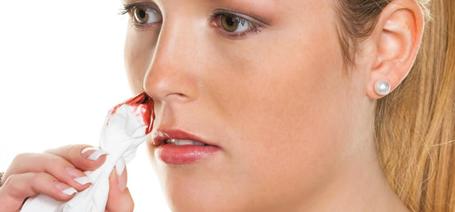 Blood in Phlegm is an Indication to Visit the Doctor Immediately Blood in Phlegm is an Indication to Visit the Doctor Immediately Green or yellow phlegm: Bronchitis, pneumonia, sinusitis and cystic fibrosis release green or yellow-colored phlegm. Brown phlegm: Bacterial bronchitis, bacterial pneumonia, cystic fibrosis and lung abscess produce rustic brown phlegm. White phlegm: Very commonly noticed, white phlegm is caused due to viral bronchitis, GERD, COPD and congestive heart failure Black phlegm: This color occurs predominantly due to smoking, pneumoconiosis and some fungal infection Clear phlegm: This might be due to allergic rhinitis, viral bronchitis and viral pneumonia Red or pink phlegm: Pneumonia, tuberculosis, congestive heart failure, pulmonary embolism and lung cancer can cause red/pink-colored phlegm Phlegm/mucous is normal and you must start worrying only when there is a change in color, consistency or volume. It becomes necessary to visit a doctor only when there is excess mucous in the chest for more than 3 days continuously, color of the mucous is green or yellow and congestion gets worse suddenly or when chest congestion is present along with breathing difficulties, chest pain, blood, fever or wheezing. ‘Laughter is the best medicine’ is not popular till date without some inner meaning to it! There have been numerable insights into laughter therapy and it was not until 1995 that laughter was introduced as an exercise form and laughter yoga was practiced in laughter clubs, public parks or gatherings by groups of people. An increasing population have recognized the benefits of laughter as an alternative medicine approach and they try using it along with their everyday medical therapies for added benefits. There are no side effects to this therapy, no fretting over overdoses or allergies, but still the medical community feels uncomfortable declaring laughter for a healthier and better community of people. Laughter does have its share of advantages:
Vascular function: Stress is a major inducer of cardiovascular disease and controlling stress is a great way to improve heart health. A study by the American Journal of Cardiology has proved that people who watch comedy movies have increased carotid artery compliance and their heart rate and blood pressure increased significantly. Cardiovascular health: A research study focused on the link between how often a person laughs and its impact on heart disease and stroke. After adjusting factors such as high blood pressure, depression and BMI, results showed that people who never/almost never laughed were at an 21% increased risk of heart disease than those who laughed daily. Also, people who rarely laughed were at a 60% higher risk of stroke than others. Reputed heart organizations recommend laughter for reduced artery inflammation and increased production of HDL cholesterol. HDL cholesterol explained concisely at www.firsteatright.com is the good cholesterol in our body that is available in a variety of foods. Natural Antidepressant & Stress Buster: Depression calls for an appointment with the psychologist/psychiatrist who recommends taking up CBT sessions and talk therapies to come out of it. None of them will be willing to recommend laughter therapy in place of these sessions. But a latest study that involved 42 individuals suffering from depression showed that laughter therapy that includes singing funny songs, laughing for diversion, healthy clapping, stretching and laughing aloud reduced depression and improved overall mood and sleep levels. Humor and laughter decrease levels of stress hormones (such as cortisol and epinephrine) and improve dopamine levels (this mediates between desire and motivation). Blood pressure levels: Hypertension is a major problem worldwide and is an invaluable risk factor for heart disease and stroke. One research focused on laughter and music therapy for patients with high blood pressure. Results showed that BP levels decreased by 7 mmHg for those undertaking laughter therapy compared to only a 6 mm Hg change in those undergoing music therapy. Anxiety & Other Negative Emotions: Laughter therapy seems to significantly reduce the impact of anxiety in patients generally, especially in those with Parkinson’s disease. It also helps to improve positive thoughts, self-esteem and reduce depression effects in menopausal women. Pain relief: Early physicians used laughter as an analgesic for pain, for instance French surgeon Henri de Mondeville in the 14th century used humor to soothe or distract patients during surgery/recovery. Research shows that people who watched comedy movies needed lesser pain medications than the rest of the group. Burn Calories: A 2014 journal studies proved that laughing helps to burn calories. A team of 45 people were split into two groups. One group was made to watch a comedy clip for 10 minutes and the other group was made to watch clips that were unlikely to stimulate laughter. Both groups were attached to a calorimeter that measured energy expenditure and heart rate. Results showed that people who watched comedy clips for 10 minutes lost around 10 calories in comparison to those who did not burn any calories. All said, a major problem with laughter research is that it’s very difficult to determine cause and effect. For example, when a study shows that people who laugh are healthier, it might also be because healthy people have more to laugh about. Most studies on laughter have also been done on a small group of individuals. Studies on laughter mostly focus on reducing pain with humor. But we don’t know if it is the laughter that is causing decreased pain or any other distraction (a thrilling drama, for instance) could produce the same effect. To conclude, there is no harm in laughing. In fact, you are doing good by spreading joy and happiness to people around you. Only take care that your laughter or jokes are not born due to other people’s weaknesses or aimed at them. The latest fitness craze is cycling. We can see cyclers with head gears and other accessories voraciously cycling their way to work (even managers and CEOs) or doing it as a form of exercise. Bicycling is one of the best ways to commute between places as it is pollution-free, good for your health and inexpensive. Cycling is said to provide the same benefits as walking, swimming, jogging or other aerobic activities.
Many people often worry about the harmful effects of cycling on reproductive organs that might disturb sexual function and previous studies did support this fact. The latest news is that cycling does not negatively affect a man’s sexual health or urinary function. This study compared a cyclist’s sexual health with that of swimmers and runners. Advantages Outweigh Disadvantages Almost 2, 774 cyclers were involved in the study along with 539 swimmers and 789 runners and these people were provided with questionnaires that measured sexual health and urinary function. Individuals across all exercise groups fared almost the same with the only exception being that cyclists were more prone to urethral strictures (narrowing of urethra). The study could not find any difference between vigorous cyclists-those who cycled for more than two years at least four times weekly covering almost 40 kilometers per day-and recreational cyclists. Same Case, 2 Studies, 2 Results The researchers involved in this study conveyed that the latest findings contradicted with previous results as the earlier study lacked comparison groups and was moreover dependent on a small sample size. The latest study confirms that:
There is nothing to panic on hearing the word ‘hear failure’. Don’t presume that your heart has stopped working or that your life is over! It is used to describe the heart functioning rate-to notify that the heart is not pumping as efficiently as it should. Heart pumps blood to deliver oxygen and nutrients to other parts of the body and when these parts are well-nourished, they perform their function accurately. During a heart failure, the heart is unable to perform its job of pumping blood and hence, other organs of the body are not supplied with enough nutrients and are unable to perform their activity. This leads to fatigue, breathlessness and even cough in some people.
Heart failure rates are increasing at an alarming rate worldwide, especially in our country. The International Congestive Heart Failure (INTER-CHF) study measured mortality rates in patients who suffered from a heart attack across a span of 1 year and found that India (23%) and Africa (34%) had the highest mortality rates! This comes as a disappointing piece of information at a time when we boast about advancements in technology and science, but in reality we are not doing much personally to improve on our health. When we are in such a bad state, how would you like it when your doctor asks you to get onto a scale and predicts your risk of heart failure by looking at the scale values? This scale does not measure your weight alone but intimates your heart health! That’s the new study done by researchers at the Stanford University School of Medicine who have discovered a new risk factor for heart failure-leg bioimpedance. This study was published in the Journal of the American Heart Association and shows that individuals who have a lower leg bioimpedance were at a higher risk for heart failure. Bioimpedance Impedance measurements garnered interest beginning in the 1940s when it was found that changes in impedance was related to changing blood volume. Since then, improvements in impedance techniques paved way for developing diagnostic and prognostic tools in cardiovascular medicine. Such developments have elicited interest in using impedance measurements to benefit in the field of heart failure management. Impedance is a measure of the degree a substance resists the flow of electrical current of a given voltage. Practically speaking, impedance measures how well the body resists current flow through the human body when a small amount of current flows though it. Generally, blood and fluid show a lower resistance to current compared to something more solid, such as muscle tissues. Bioimpedance analysis is widely used in body composition measurements and healthcare assessments. Whole-body bioimpedance has been practiced for quite a long time but not much research has been done on leg bioimpedance for heart failure. Monitoring body weight and body fat percentage gives an idea about body composition changes and also helps to predict heart failure status. Combining the body weighing technique along with bioimpedance techniques helps to monitor heart failure status. The Study The researchers involved analyzed data of over 5,00,000 UK patients aged between 49 and 69 years to find any clues on new risk factors for heart disease. They used 3,646 variables pertaining to health, lifestyle and disease-related factors for every patient with the help of computer-assisted techniques and the results obtained are not surprising-occurrence of a previous heart attack, chronic heart disease and diabetes were top factors for heart failure. Along with these was a surprising addition-leg bioimpedance. The excited research team focused on this factor as this is a new risk factor as well as an easily measurable one. They measured bioimpedance using a body composition analyzer which looked like a standard scale but with handlebars. Electrodes fit under each foot were used to send small electric currents and measure impedance (resistance) in the tissue. As stated above, fluids such as blood and water are strong conductors of electricity and hence, show less resistance compared to muscle tissues that show greater resistance. The researchers predict that individuals who had lower leg bioimpedance could have already had some fluid buildup in their legs, a common sign of a heart failure. The low impedance rates could have determined water retention levels that were yet to be diagnosed by physicians and even before any signs of heart failure set in, such as fatigue or breathlessness. The researchers feel that there are a number of individuals who experience abnormalities in the hearts and lungs that cause symptomatic heart failure but sadly, don’t recognize/experience any of these symptoms as they are strikingly sedentary. Start leading an active lifestyle by getting in touch with a reputed RDN at www.firsteatright.com. Even after analyzing such a large group of individuals the researchers find it necessary to repeat the study to confirm the results thoroughly. The team proudly feels that the simple algorithm they develop could help to predict the risk of heart failure within eight years. So, when you stand on the scale, you get double rewards-in addition to you body fat percentage you also get to know your risk of heart failure within the next 8 years! The formula would contain the patient’s age, sex and details whether the patient previously suffered from a heart attack or not. Leg bioimpedance could be a blessing in disguise for predicting the risk of heart failure in people who lead an exceptionally sedentary lifestyle. Pregnant women hear everything right from ‘The way your tummy looks, it’s definitely going to be princess,’ ‘Your baby is going to pop out with lots of hair, don’t worry! Your heartburn is an indication,’ ‘Baby’s heartbeat under 140? It is a boy, my dear,’ to ‘If you have vomiting or nausea, the chances of a miscarriage are unlikely.’ While others face outright rejection as myths, the last one may be scientifically true (even this was ridiculed to be false until now) which comes as a warm welcome to all the superstitious and myth-believing candidates out there!
Are You Pregnant with Morning Sickness? Pregnancy brings about enormous changes physically and mentally. The first few months (first trimester) might make the pregnant lady feel miserable with nausea, vomiting and other food choices taking a toll on the pregnant woman’s health. More than three-quarters of women complain of nausea with/without vomiting in early pregnancy. Nausea and vomiting that occur during pregnancy is called as ‘morning sickness’ and is named so as most of the symptoms begin in the morning and decrease/resolve as the day progresses. In general, both these symptoms diminish mostly after the first trimester but rarely, some women experience it even until their due date (extremely rare). Morning sickness affects quality of life of pregnant women as it affects their daily activities and diminishes well-being. Despite being present unanimously in most pregnant women researchers are still inconclusive on the causes. They put forth their theory that this is one way of protecting the developing fetus against toxins and disease-causing organisms in foods. It might also occur due to the increased hormone levels in the body. To bring some integrity and justice to the long-believed myth regarding morning sickness, a group of NIH researchers have gathered some of the most convincing evidence to date that nausea and vomiting, common symptoms of morning sickness, may indicate something critical and important-a reduced risk of miscarriage. Reduced Risk of Miscarriage Women experiencing morning sickness in their subsequent pregnancy after a series of miscarriages in earlier pregnancies were 50-75% less likely to miscarry than those without any signs of nausea or vomiting. The exact cause and the underlying reasons are not clear, but the facts do support the belief that morning sickness might be the result of biological factors that increase the likelihood of a successful pregnancy. The study followed-up on 1,228 women who suffered from one or two previous miscarriages and tracked them for up to 6 menstrual cycles as they tried to conceive. The average age of these women was between 18 and 40 years. Of the 1,228 women a total of 797 women became pregnant and these women were requested to maintain a daily diary of their pregnancy which contained details of whether or not these women suffered from nausea and vomiting. Between the 12th and 36th week, the remaining number of pregnant women (almost a quarter of them miscarried by the end of the first trimester) were given monthly questionnaires to describe their symptoms. Based on the data in hand, researchers found that 20% of women started feeling nauseous only after two weeks of pregnancy and the numbers climbed to around 84% by week 8. Of these, almost 27% women suffered greatly from vomiting episodes. The risk of miscarriage reduced by 50% when women experienced nausea alone and reduced by 75% when nausea was coupled with vomiting. Although researchers are still not clear about the reason behind morning sickness and reduced pregnancy risk, they feel that nausea and vomiting might be signs of increased pregnancy hormones or the presence of a healthy placenta to nourish the developing fetus. One needs to remember that nausea and vomiting might be good signs of pregnancy, but they are not confirmed tickets for a healthy pregnancy. Also, there is no need to panic in the absence of these two symptoms and rush up to the conclusion that your pregnancy is at risk. For any concerns or queries regarding your pregnancy, its always recommended to consult your doctor. Ensure a healthy pregnancy, stick to your healthy weight gain limits and eat nutritious foods before, during and after pregnancy to deliver a healthy baby. Get in touch with a nutritionist/dietitian at www.firsteatright.com to help you select the most-healthy foods that should be consumed during pregnancy. You bend down to pick something and feel the entire room spinning around you and fear that you might faint anytime. We term this as dizziness and this can cause different sensations in different people. Dizziness can be the feeling that occurs when we stand up suddenly, the feeling of movement while we are standing still or light-headedness. Commonly affecting the older generation, it can affect a person of any age group. Almost all individuals experience dizziness at some point in their life and most of the times it is non-indicative of a disease. But, if dizziness is accompanied by double-vision, vomiting, trouble moving your hands/legs or problem doing work, it is better to give a visit to your physician immediately.
Causes Some of the most common causes of dizziness include: Poor Blood Circulation: If blood does not circulate oxygen properly throughout the body, the brain does not get its proper share of oxygen and the slightest movement of bending down or getting up can make the person feel dizzy. If this is the case, it is better that the individual visits the physician as it is an indication of a bigger problem such as a heart attack, abnormal heart beat or congestive heart failure. Low Blood Sugar: Skipping meals makes us quite dizzy due to low blood sugar levels and this is specifically visible greatly in diabetic people. Low Blood Pressure: Individuals experiencing low blood pressure levels feel dizziness when they move their head, bend to pick something or stand up suddenly. Dehydration: Insufficient water levels in the body causes dehydration which might be due to vomiting, illness, exposure to hot weather, exercise and staying for a long time without drinking enough water. Such decreased water content causes difficulty in brain functioning leading to dizziness. Anemia: Here again, there is less oxygen supply to the brain resulting in dizziness or lightheadedness due to lack of oxygen-rich red blood cells in our body (anemia). Side Effects of Medications: Individuals put on new medications such as pain relievers, diuretics, tranquilizers, sedatives, antidepressants or blood pressure medications can lead to dizziness. Inner Ear Problems: Inner ear is said to regulate a person’s body balance and ear infections can make a person feel dizzy when standing up or bending. A person might hear a ringing sound in the ear and face inner ear problems called vertigo which is common when calcium particle from one part of the ear moves to another part of the ear. Other possible causes include stress, anxiety, migraine, motion sickness, atherosclerosis and labyrinthitis. Stress is a silent killer which is not obviously visible but takes a toll on your everyday life. There are simple yet tactical ways to deal with stress as given in the website www.firsteatright.com. Do’s & Don’ts for Treating Dizziness Dizziness does not need any treatment and usually goes away on its own. You can do a few things from your side to minimize its side effects: Do
|
AVOID FRAUD. EAT SMART.+91 7846 800 800
AuthorDietitian & Nutritionist Dr. Nafeesa Imteyaz. Archives
July 2024
Categories
All
Dr. Nafeesa's Blog @blogspot |
- Home
- Written Testimonials
- Consult
- Clinics
- Blogs
-
Diet & Nutrition
- Diabetes Reversal
- IVF IUI not needed for PCOS PCOD Infertility
-
Medical Nutrition
>
-
Disease & Conditions
>
- Infertility | PCOS
- Diabetes Mellitus
- Cholesterol
- Hypothyroid
- Kidney Problems
- Hypertension
- Cardiovascular Diseases
- Liver Diseases
- Gastro intestinal disorder
- Cancer
- Metabolic Disorders
- Orthopedic Disorders
- Eating Disorders
- Dietary Recall
- Weight Record Filled By Clients
- Online Payment Transaction Details
- Online Clients Weight Check Form
- Our Program Package Service Charges
- Weight Record 2017 Clients
- Measurements sent by Clients
- Terms & Conditions Of Payment
- Thanks. Your Form is Submitted
- Video Testimonials
- Lifestyle & Wellness
- Lifestyle & Wellness Blog
- Allergy & Intolerance
- Weight Loss / Gain
- Weight Loss / Slimming Blog
-
Disease & Conditions
>
- Life Cycle Nutrition >
- Sports Nutrition >
- Integrity in Nutrition
- Knowledge Centre
© COPYRIGHT 2022. ALL RIGHTS RESERVED. FRST HEALTHCARE PVT LTD.
Dr. Nafeesa Imteyaz of First Eat Right clinic, is the Best Dietitian Nutritionist in Bangalore. Best Dietitian Nutritionist in Pune. Best Dietitian Nutritionist in Hyderabad. Best Dietitian Nutritionist in Chennai. Best Dietitian Nutritionist in Mumbai. Best Dietitian Nutritionist in Delhi. Best Dietitian Nutritionist in Kolkata.


